

ART

HA B E N S
Australia


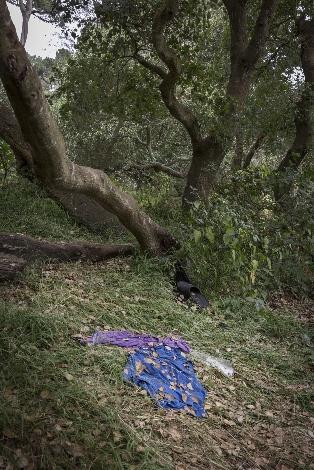
With the development of globalisation, dramatic changes and perception of individuals in global society have, in turn, changed the nature of its art. Xiuwenbo presents a series of printmaking artworks which confound outmoded expectations about humanity, reflecting unflinchingly on the most undeniable truths of our times. He engages with global issues discourses, adapt printmaking with traditional fine art and mixed media, reinvent traditions and challenge controversial and social taboos. Playful, irreverent, and sometimes downright subversive, the subjects range from intimacy to privacy, from solitude in a crowd to traumatic stories brought by unclear future, from the unknown to experiences of known.
Dominique Czerednikow is self-taught visual and digital artist. Freely developing her passion and artist education through forged life experiences and experiments.


Oil painting has been her primary medium for the past 12 years however technology has stimulated her to search further into her worlds. Emerging over the last year her digital works are exhibited in international digital collections in Miami, Paris and Dubai. For her oil painting is sacred but technology is powerful.As an artist, art lover and art ambassador the idea behind her work is to share strong sensations. The feeling of losing oneself in a work of art is a human necessity.
I am producing works of art that resemble how I perceive my surroundings, with a "bardo" lens. What is the bardo? You knowlife/death, well, that middle space between life and death, depending on your belief of course, well that’s the bardo, the in-between. My paintings are how I imagine that plane of existence to appear: how our world and our surroundings are perceived by those in or traveling thru the bardo! I paint with a heavy hand and loud colors. To reveal the bardo in the everyday images that I work from requires a bit of blurred distinctions, curious perspectives and lucid pallets.
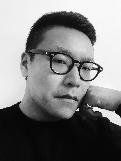


Cidgy Bossuet is a visual artist/ photographer currently based out of Boston, MA. She holds a Bachelors of Fine Arts in photography from Massachusetts College of Arts & Design. Her work evolves from a journey of self-discovery and self-expression. In the process, she often draws her inspiration from life experiences, people, and observations/ the world around her. With her work, she experiments with different modes of photography, appropriated images and digital imaging. Cidgy is interested in making photographs that honor/ highlight the cultural identity of people of color, specifically black identity.

Bosnia and Herzegovina
The work of Zoran Crncevic deals with the message and code that live in an arena where ideas are let to transcend cognitive distance between people. His work does not have a subject, object, or justification. It does not depict, symbolize or represent. There is no obvious key to reading his work. In a printed and digital domain, Zoran’s photo abstracts are created as abstractions of his multidimensional aesthetic experience. During the exposure that could sometimes last for over two sseconds, he changes the focus of a lens and moves camera forward-backwards and left-right on the same plane.
Through the exploration of visual myth-making Larissa Monique Hauck expands on concepts surrounding vulnerability and unconsciousness as a vessel for the duality between human fantasy and reality, between our base desire and rebellion. She creates hybridized creatures that reference contemporary fairy tales combined with botanicals and animalistic traits that develop into a transformative state reflecting on the fleeting aspects of time and permanence. Each intimate artwork acts as an endeavour to divulge and expose personal insecurities and feelings of isolation through storytelling. These notional subjects respond to concerns within folklore and literature surrounding femininity, environmental intimacy, and the natural order of life & death.

 Nam
Nam

My life as an artist has always displayed a uncertainty about this mundane world. To me, this world is multifaceted: whilst some of its chaotic parts are desiring for freedom and peace in societies, there exists some places that look satisfying on the surface, but their soul somehow get lost. I don't say modern art isn't good, but it seems like, you know, people are still reminding themselves of great arts that belongs to the old world, where freedom is conveyed better. All of that always inspires me to think about how to reflect all of them in art. To be specific, I have tried to show the interaction and the generalizing perspective of life in my current artworks. In the future, what I am pursuing is more concepts of living space, cultural continuity, and of course freedom.
KingdomMy paintings are paint poems. I am interested in creating a sense of movement through an imagined physical space by exploring marks and colours using combinations of layered oil paint, acrylic paint and sometimes ink. I want to cross the boundaries of imagined reality and visual reality to create a reflection of thoughts in paint. Much of my work contains references to landscapes as a meditation on the cycles of life and emotional connections to the land. Often I am thinking about connecting with the underlying energies of Nature through the possibilities paint suggests, and searching for a new reality on canvas.
Art should be thought provoking, expressive, and enchanting. It should gather people together and yet allow for solitude and quiet contemplation. It should mean something to those who acquire it and even more to those who create it. Art should come from a place of passion and longing. Using the ordinary and the everyday my work focuses on at least a few themes: family, community, and peace. Subtlety is a method that I take to deliver messages in my art so as not to dictate what the viewer sees, but offer a slight nudge so that they might look at objects in life with a new-found affinity. I hope that they will appreciate the beauty around us and see beyond what is in their peripheral vision. More and more, nature and urban life are fusing, and we must find that place where we can coexist.
Special thanks to: Charlotte Seeges, Martin Gantman, Krzysztof Kaczmar, Tracey Snelling, Nicolas Vionnet, Genevieve Favre Petroff, Christopher Marsh, Adam Popli, Marilyn Wylder, Marya Vyrra, Gemma Pepper, Maria Osuna, Hannah Hiaseen and Scarlett Bowman, Yelena York Tonoyan, Edgar Askelovic, Kelsey Sheaffer and Robert Gschwantner.


Lives and works in Banja Luka, Bosnia and Herzegovina
Detail - Untitled yellow, red, blue - abstract, acrylic on c
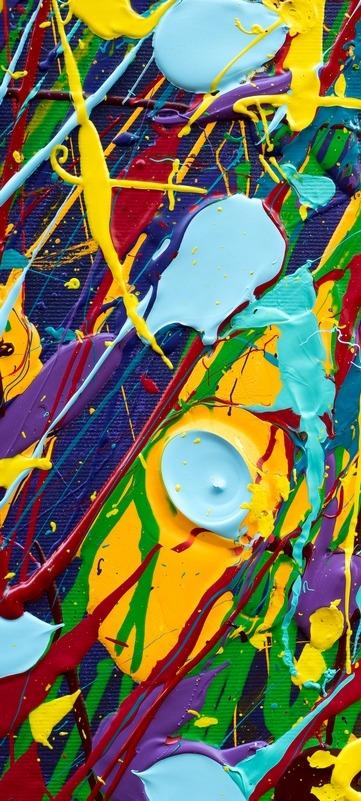
anvas (160 x 120 x 3.8 cm 63 x 47 x 1.5)

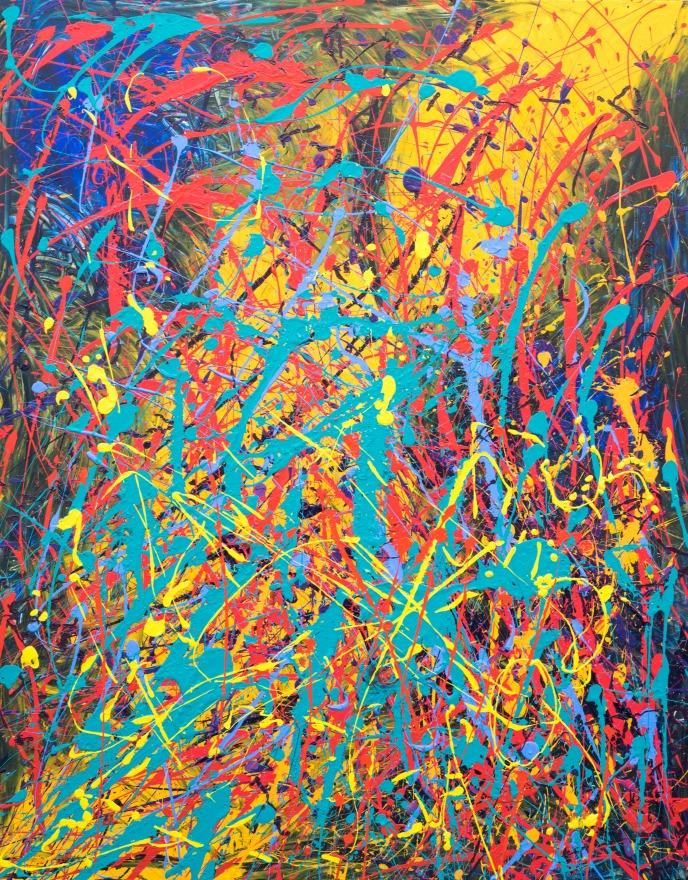
Hello Zoran and welcome to ART Habens. Before starting to elaborate about your artistic production we would like to invite our readers to visit https://www.crncevic.art and we would start this interview with a couple of questions about your background. You have a solid formal training and after your studies at the Faculty of Arts of the University of Pristina, you earned your BA(Hons) in Fine Art from the prestigious Wimbledon College of Arts, University of the Arts London: how did those formative years influence your evolution as an artist? Moreover, how does your cultural substratum direct your current artistic research?

Zoran: Pristina was culturally very rich and very different from any other city I had visited before. Despite the ethnic hatred and conflict between Serbs and Albanians, it, sort of, added on my childhood experience of growing up in Banja Luka, in a neighborhood where kids from Communist, Christian, Muslim, Jewish, and Roma background all played together, not being aware of the differences that will, unfortunately, become so significant
Zoran Crncevic
during the upcoming civil war. I came to Pristina with one war behind me, only to witness similar warmongering rhetoric and build up for another war that broke out a year later. Despite all the anxiety and anticipation of the upcoming disaster, I fully embraced the opportunity and my time there,
Zoran Crnceviccherishing every moment and living my dream of studying art. I learned a lot about myself over there. I met lifelong friends. There was so much soulsearching and love in Pristina at the time that it was overwhelming. And probably the most important thing that happened to me in Pristina is that after several sleepless nights, I learned how to lose myself into art, how to connect with the work, how to code it. Later, I met great people at Wimbledon College of Arts, and tutors over there were simply amazing. They were asking the right questions. That was probably the most valuable thing. Studying at Wimbledon was a mindopening experience.
Marked out with such unique visual identity, the body of works that we have selected for this special edition of ART Habens —and that our readers have already started to get to know in the introductory pages of this article — has at once captured our attention for the way you use your visual language in a strategic way to counter-balance subjectivity, offering an array of meanings. As you have remarked once, you start from a vague idea of the outcome, and you later develop your paintings beyond the point where you could declare them



finished: when walking our readers through your usual setup and process, would you tell us how do you consider the role of chance and improvisation playing within your process?
Zoran: Despite being abstract and seemingly spontaneous, the process I go through is not random. There is a mental blueprint that I work from, so there is not much chance or improvisation. I believe that the final outcome is predetermined, so to speak.
Your artworks often feature bold and vivacious tones that provide your canvass with such sense of dynamics. How does your own psychological make-up determine the nuances of tones that you decide to include in your artworks?
Zoran: My work deals with communication and its cultural and cognitive limits. We have an ability to tune into each other minds since our brains work like transmitters and receivers on the conscious and subconscious level. Some of the most gruesome events in history happened due to this lack of understanding of our own nature. We are not lone wolfs, we thrive and prosper in stable


Detail - Untitled blue, yellow, red - abstract, acrylic on canvas (160 x 120 x 3.8 cm 63 x 47 x 1.5)
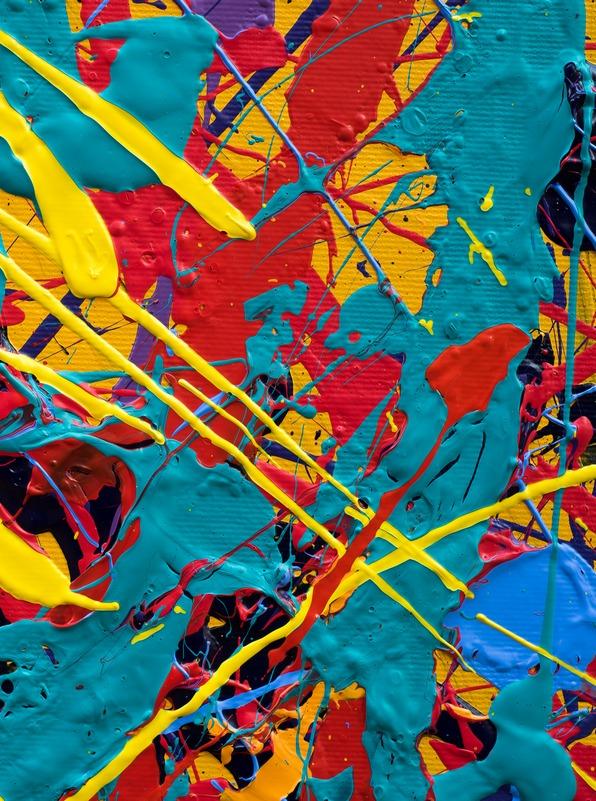
and progressive communities. In the 20th century, people from Bosnia and Herzegovina experienced more history than a human mind can or should process. The First World War started on 28 June 1914, when Gavrilo Princip assassinated the Austro-Hungarian heir, Archduke Franz Ferdinand, in Sarajevo.
Then, in the Second World War, partisan guerrilla fought fascists all over Bosnia and managed to defend large territory throughout the war, when most of Europe was suffering under Nazi rule. Nearly one million people perished in Bosnia and Herzegovina during WWII, many of whom were children, and many more continued to suffer from war traumas for decades to come. To escape genocide and pogrom, my grandparents had to flee their homes with their children and go deep into the woods. My father was only 10-yearold when the war started, but he often spoke about these events. Through his storytelling I sensed the fear and anxiety he suffered as a child, hiding in the mountains with his parents, brothers, and sisters. Those stories marked my early childhood, and just when I was approaching my late teens, we had
another bloody war starting in Bosnia and Herzegovina.

20 x 3.8 cm 63 x 47 x 1.5)
We have appreciated your successful attempt to draw the viewers to a state of mind where concepts of space and time became suspended.

With their unique multilayered visual quality, your artworks highlight
contours of known reality in an unknown world and seem to invite
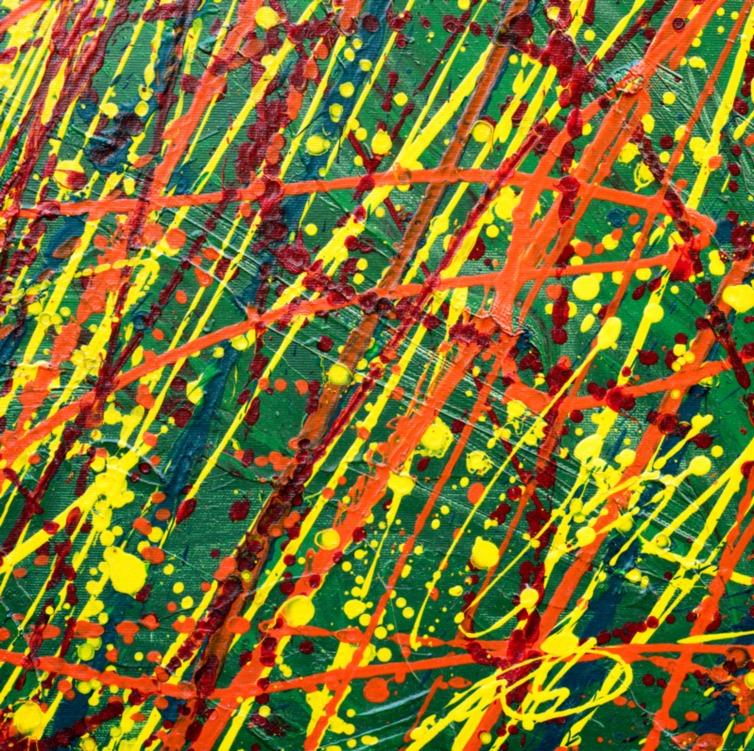
the viewers to look inside of what appear to be seen, rather than its
surface, providing the spectatorship with freedom to realize their own perception: how important is for you to trigger the viewers' imagination in order to address them to elaborate personal interpretations? In particular, how open would you like your works to be understood?
Zoran: If there is a purpose to my work it would be to trigger the viewers' imagination, to give people the freedom to realize their own perception. I want to draw viewers deeper than they would usually go by looking at a representational artwork.
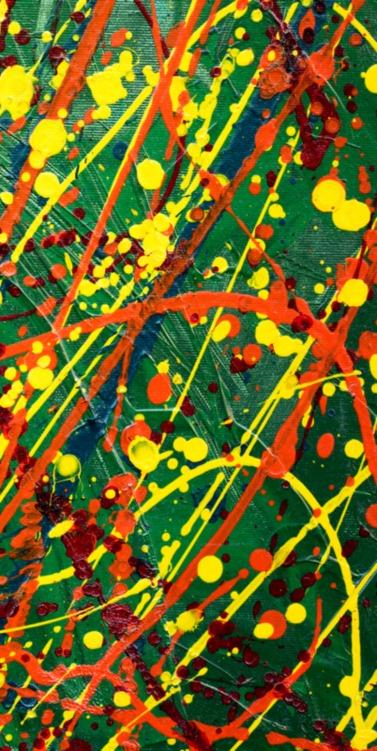
I think that representation, if not handled carefully, can misguide our perception and ruin the experience of an artwork.
As you have remarked in the starting lines of your artist's statement, your works do not have a subject, object, or justification. It does not depict, symbolize or represent. Scottish painter Peter Doig once remarked that even the most realistic paintings are derived more from within the head than from what's out there in front of us: as an abstract artist, how do you consider the relationship between

Detail - Untitled green, yellow, red abstract, acrylic on canvas (160 x 120 x 3.8 cm 63 x 47 x 1.5)

Untitled blue, yellow, red abstract, acrylic on canvas (160 x 120 x 3.8 cm 63 x 47 x 1.5)

reality and imagination, playing within your artistic production?
Zoran: My work has no reference in nature or the world. People perceive reality in their own, unique way, and I leave it to viewers to feel and decide how they experience it.
Sometimes I look at my paintings together with my friends or family, and we all see different things.
You started transforming found objects and burning furniture, wooden boxes, and newspapers in 2002 while you were studying at the University of the Arts London. New York City based photographer and sculptor Zoe Leonard once stated, "the objects that we leave behind hold the marks and the sign of our use: like archeological findings, they reveal so much about us". We’d love to ask you about the qualities of the materials that you include — or that you plan to include — in your artworks: in particular, how important is for you to use materials rich of metaphorical properties in order to create such allegorical artworks, that invite the viewers to investigate the traces left by time?
Zoran: Metaphorical and physical properties of the material are very important. Every time I use new materials I experiment for a while, before making a mental blueprint for my future work. For example, I don’t paint in the same way with oils as I do with acrylics. The viscosity of the paint, drying time, opacity and brightness of colors, all are different depending on the medium. I also like switching from canvas to photography and to furniture. It resets my preconceived plans, and I start from a clean slate. I like experimenting.
You often work with large canvases that provide the viewers with such immersive visual experience: how do the dimensions of your canvass affect your workflow?
Zoran: Large canvases take more effort, but with any size, material or space, I always develop my work in stages, building layer upon layer, working with what I have at hand. I find it very exciting to develop a completely new strategy with every new piece of work. Whether I create performance or installation work, take photos, or work with furniture, acrylics, and oils I always start from space and materials I intend to use. I
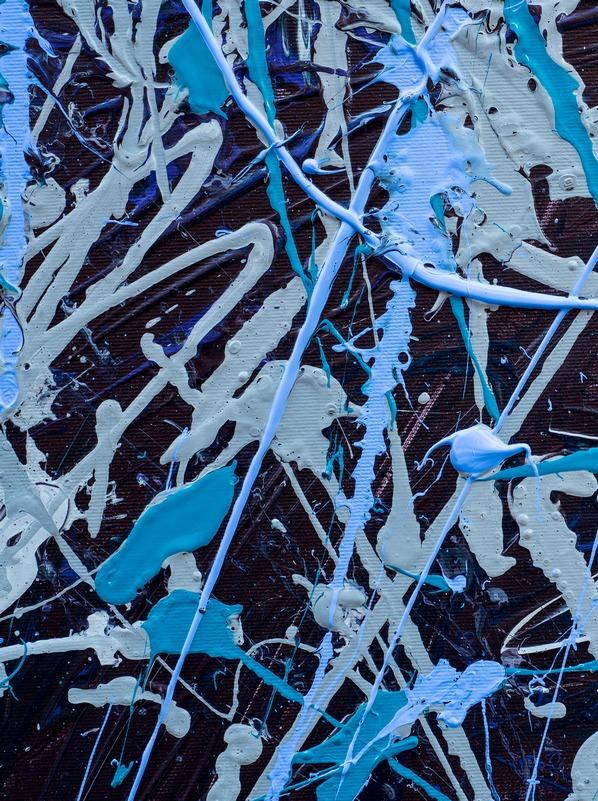

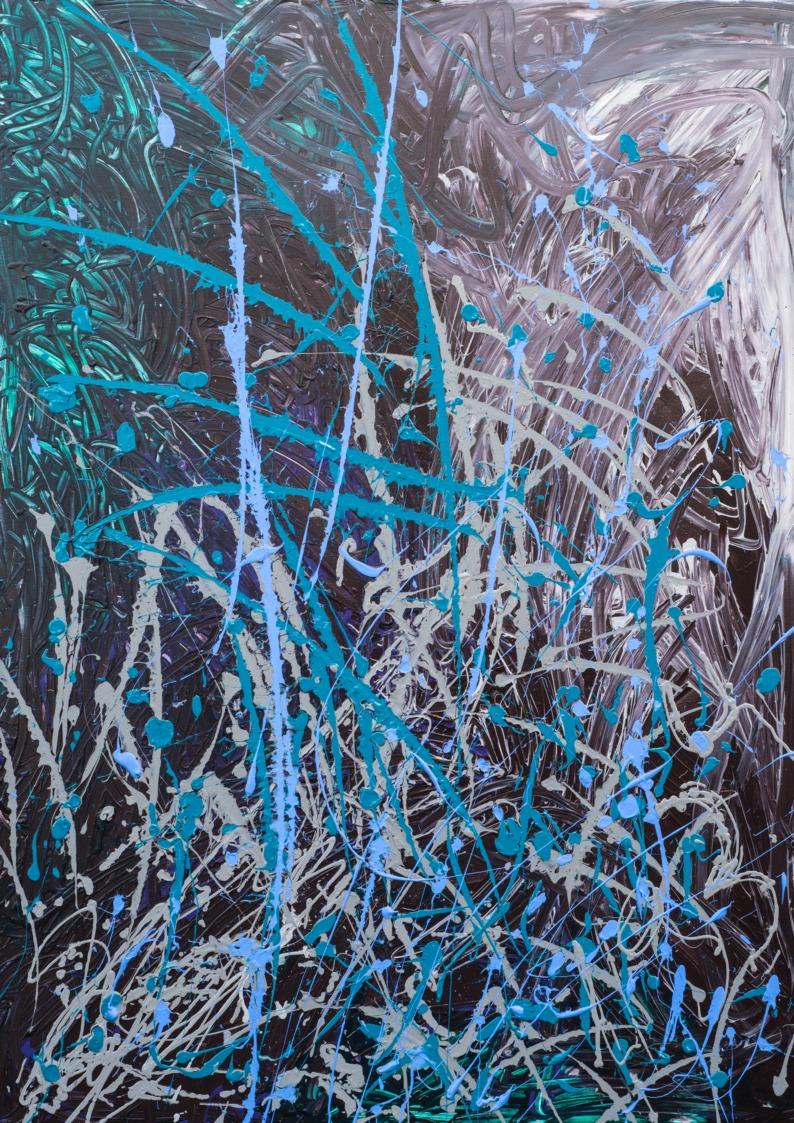 Untitled blue - abstract, acrylic on canvas (160 x 120 x 3.8 cm 63 x 47 x 1.5)
Untitled blue - abstract, acrylic on canvas (160 x 120 x 3.8 cm 63 x 47 x 1.5)
never make the work without thinking about the space, or how the visual and chemical properties of materials impact the final piece.
Your artworks are in a number of collections in United Kingdom, Italy, Ireland, and Bosnia and Herzegovina, and over the years you have exhibited in several occasions: how do you consider the nature of your relationship with your audience? Direct relationship with the viewers in a physical context is definitely the most important one, in order to snatch the spirit of a work of Art. However, as the move of Art from traditional gallery spaces, to street and especially to the online realm — as Instagram — increases: how would in your opinion change the relationship with a globalized audience?
Zoran: I have shown my work in the gallery and non-gallery settings, and I think that there isn’t much difference in that respect. However, although I regularly update my web site and have an active profile at https://www.instagram.com/theplacef or.art, people who appreciate my work say that there is no alternative to seeing it in person. To change the relationship with the globalized audience, artists should write more about their work and place it in the
context of their cultural and conceptual background. This could help online viewers to experience the work more fully.
We have really appreciated the originality of your artistic production and before leaving this stimulating conversation we would like to thank you for chatting with us and for sharing your thoughts, Zoran. What projects are you currently working on, and what are some of the ideas that you hope to explore in the future?
Zoran: Thank you, I am grateful for this opportunity to talk about my work. At the moment I am working on several paintings and a couple of photography projects. I explore digital medium by changing the focus of a lens and moving camera forward-backward and left-right during long exposures, so, in this way, I paint an image onto the camera’s sensor. The final result is expressive and dynamic, but the final photographs have no reference in nature, the world or any other theme. I believe that my photography work very closely resembles my work on canvas and vice versa.

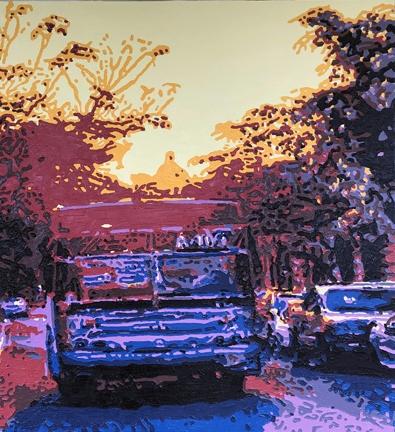
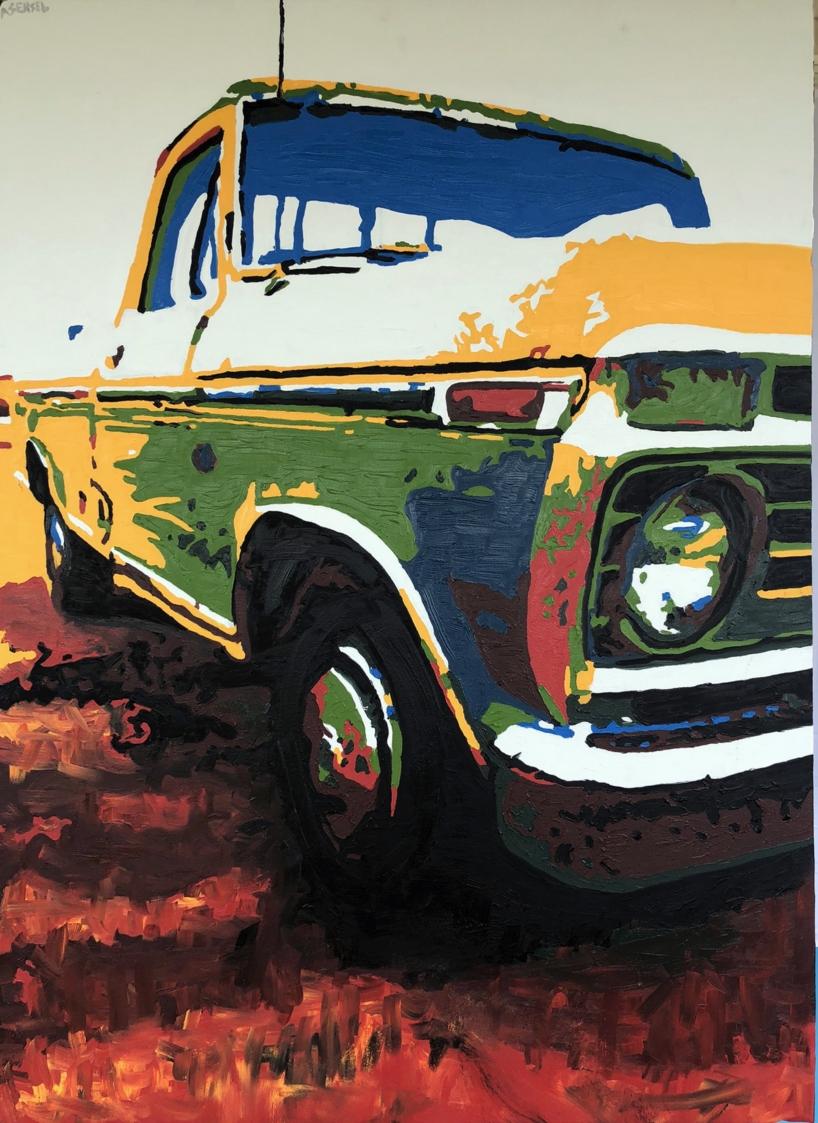
Hello Adam and welcome to ART Habens. Before starting to elaborate about your artistic production we would like to invite our readers to visit https://www.adamsensel.com and we would start this interview with a couple of questions about your background. You have a solid formal training and you hold a Bachelor of Fine Arts, that you received from West Virginia University: how did those formative years influence your evolution as an artist? Moreover, how does your cultural substratum address the direction of your current artistic research?

Adam Sensel: Hello ART Habens, thank you so much for this opportunity. I grew up around art, my mother and one brother are both creatives and my father was a handy man and tinkerer. I was given ample room in my childhood to explore and be curious. My time at WVU simultaneously expanded and focused my gaze. I was being introduced to a myriad of life experiences, art practices and procedures, theory and knowledge. The most notable and distinct revelations that have stuck with me were the observation made to me about my heavy handedness and my epiphany in seeing color truly and clearly. I remember these evolutions. The heavy handedness came from an instructor in a drawing class. They noticed my application of the charcoal and conte crayon and encouraged me to explore it and develop it. Challenging me to make it my own and utilize it’s qualities. My mastery of color was born from mixing a color for a painting. It had to be just the right hue and took a lot of staring, mixing and comparing, and seeing the subtle nuances of the other colors with in, that built the color I was striving for. Fast forward to now and I’ve set out on an artistic path that is
Adam Sensel
combing my talent and feel for painting with the experience and knowledge I gained from silk screening to develop my current processes and productions.
Marked out with such unique visual identity, the body of works that we have selected for this special edition of ART Habens —and that our readers have already started to get to know in the introductory pages of this article — has at once captured our attention for the way you
Adam Senseluse your visual language in a strategic way to counter-balance subjectivity, that — as in the interesting Peace New Orleans — challenges the viewers' perceptual parameters. When walking our readers through your usual setup and process, would you tell us how do you usually develop your initial idea for your artworks? Do you create your works gesturally, instinctively? Or do you methodically transpose geometric schemes?
Adam Sensel: I remember growing up going through grade school, I learned differently than most others, or what was the traditional way of educating in the early 80’s wasn’t working for educating me. I was young, kindergarten aged, thought to have a learning disability. So, I was subjected to a lot of remediation, tests trying to measure my cognitive, and environmental or physical functioning. I remember being given the Rorschach test when I was 5. Though I don’t really recall the actual ink blots I remember the environment I was in during. Its blurry and hazy but distinct. (probably one of my earliest instances of a bardo lens) The Smells and sounds the feel of the place, I recall all these with maybe perhaps a little manufacture imagination. I know I benefitted from all that help, what I’ve only recently come to realize is all that remediation not only aided my ability to learn it heightened my senses and perceptions. The most effective way I absorb knowledge or perceive things is a fully body experience. What I mean by this is that I engage all my senses to learn. Give me a book and the words on the page I can read them but may not necessarily absorb them. Let me listen to the words and set me on a task for example like washing dishes and I will absorb every word. Its like a movie projector in my head gets turned on and I can see and feel what’s being described. I develop my initial idea for a painting with the same need or desire to engage my senses. My process is an amalgamation of technology, silk screening



practices and painting. As a rule, I like to work from photographic imagery I have a connection to, either I have captured the image, I was present when the image was captured or I personally know who captured the image and that image they captured, captures me! Sometimes I know the moment I snap a picture that, bam, I have an image that will traverse to the bardo well, other times I don’t know till the digital editing that it will work. Peace New Orleans was a picture taken by my wife but when I began playing with the image, I could feel the street, smell the air, and hear what was going on. From here I take the image and begin manipulating the hues, tones, colors and orientation. Engaging the senses! I use graphic software like photoshop and Illustrator to generate my sample to then be used as the final image that goes on the canvas. From here its mixing the colors and applying three coats of paint. The first coat goes on thin to just get the form on the canvas. The next layer of paint goes on with attention to filling gaps and correcting any form issues. The third layer is all about the color correctness and heavy paint. That’s it a finished work after three layers of oil paint.
You paint with a heavy hand and we have particularly appreciated the way your loud colors creates tension and dynamics. How does your own psychological make-up determine the nuances of tones that you decide to include in an artwork and in particular, how do you develop your textures in order to achieve such brilliant results?
Adam Sensel: I would describe myself as an intuitive introvert with a morbid sense of nature, high energy and fantastical humor. A friend of mine told me that for people to understand me they need to understand that I like to play with concepts, i.e. abstract ideas or general notions, and I like to bleed them into other concepts. My paintings are an external


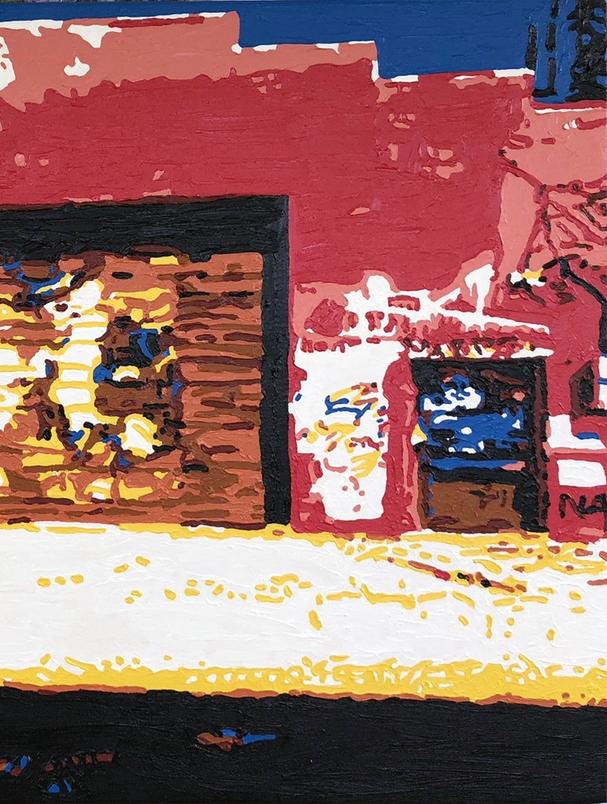
expanse to my internal minds eye. The loudness of my colors I contribute to this feeling that we are surrounded with
overwhelmingly bland and neutral colors in our daily lives. I eat with my eyes. The color loudness is also vital to pushing an image into
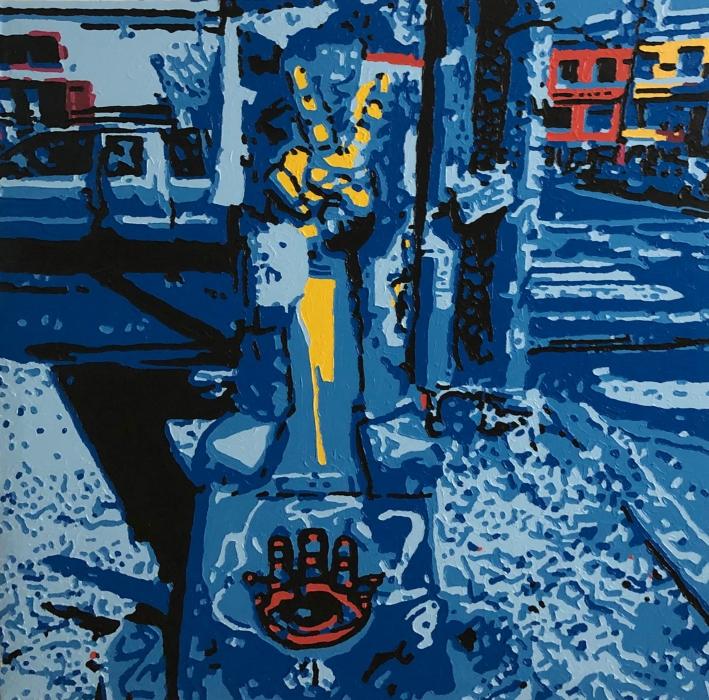
that other worldly realm that I strive for. My textures I thought were merrily the result of the paints application with a heavy hand. I
have begun understanding that my perception of the bardo, this other plain of existence, requires that the fluidity of the paint and the
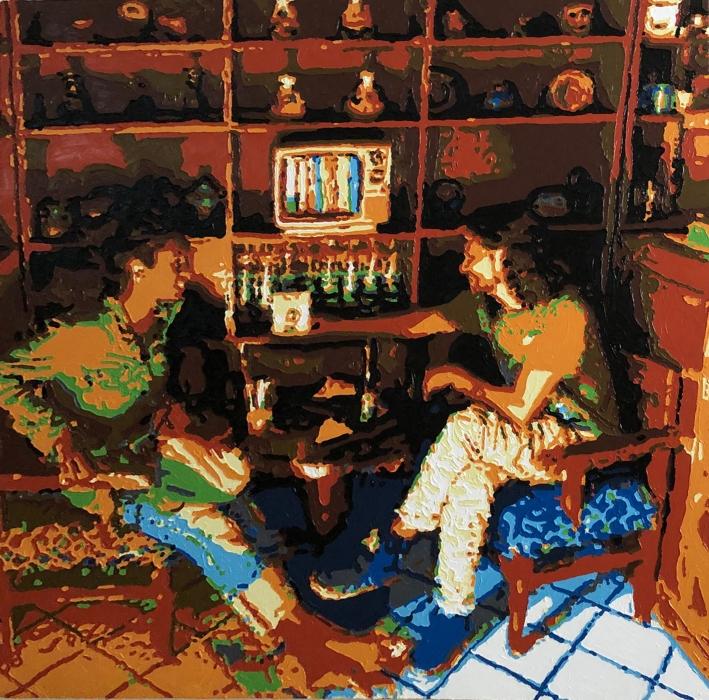
A Dove Conversing with Statues

texture be over exaggerated and tangible. It must have the feel of intense encapsulation. So, the buildup of paint is what creates the
texture, but I am utilizing what was originally just method and aligned it to relate how the bardo feels to me, this textured fluid

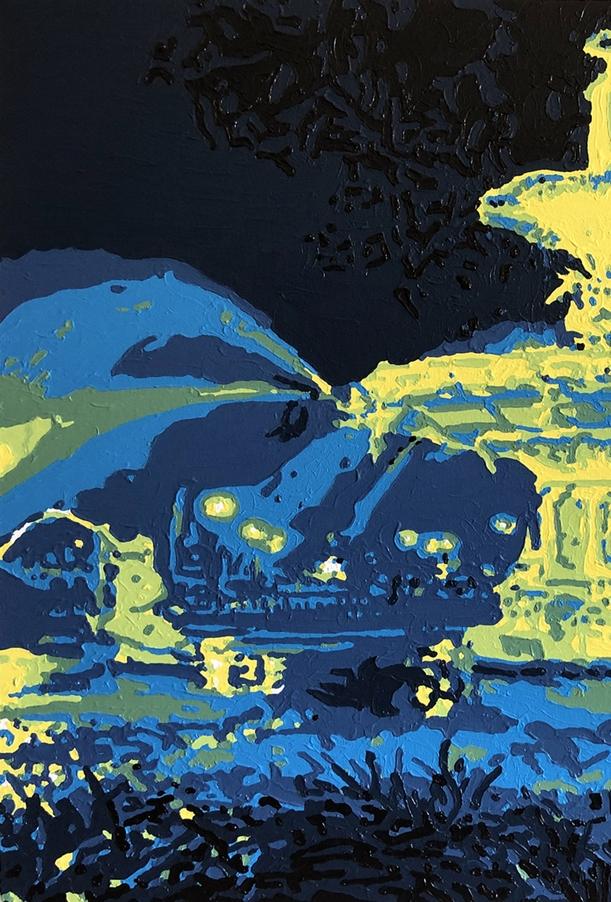


encapsulation with intense loud colors and blurred distinctions of our surroundings.
With its powerful combination between elements from real world and such dreamlike
ambience, Thankful for Forsyth Sprites seems to reflect the words that you underlined once: to reveal the bardo in the everyday images that you work from requires a bit of blurred

Snow Trespassing
distinctions, curious perspectives and lucid pallets. British painter Peter Doig once remarked that even the most realistic paintings are derived more from within the head than
from what's out there in front of us: how do you consider the relationship between reality and imagination playing within your artistic production?



Adam Sensel: I first discovered the bardo when I listened to the novel by George Saunders called, “Lincoln in the Bardo”. It wove this tapestry of historical fiction surrounding the death of Willie Lincoln and his perceived time and happenings in the cemetery while lingering after death. The lucid and lucent descriptions by the author, played out by the many different actors voicing all the characters illuminated for me this relationship of reality and imagination. Peter Doig’s observation rings very true to me. Both reality and imagination surround us in everything we do. Sometimes one takes the forefront over the other but cannot eliminate the other altogether. I like to play closer to the center where reality and imagination combine and become merged. These ideas of blurred distinctions, curious perspectives and lucid pallets for me are how I achieve the merged affect.
As we can read in the introductory lines of your artist's statement, you produce works of art that resemble how you perceive your surroundings, with a "bardo" lens: how does everyday life's experience fuel your artistic research?
Adam Sensel: We cannot know what we don’t know, we can only know we don’t know it. The moments of everyday life elevate this understanding. My perception is 100% my reality and I am always looking and feeling for subject matter to paint. It’s a conscious effort to be open to my surroundings. If it grabs me then I am obliged to capture it and try and spin it into a bardo scene. Everything I need to flourish is out there waiting to be discovered, I need only take a walk around to find it.
With its unique multilayered visual quality, Sunset Bus Oaxaca seems to highlight contours of known reality in an unknown world, to invite the viewers to look inside of what appear to be seen, rather than its surface. Austrian Art
historian Ernst Gombrich once remarked the importance of providing a space for the viewers to project onto: how important is for you to trigger the viewers' imagination in order to address them to elaborate personal interpretations? In particular, how open would you like your works to be understood?
Adam Sensel: Absolutely I want to trigger the viewers imagination. My perception is that traversing the bardo is an assault of the sense. All the bad connotations aside, the assault I mean isn’t necessarily an ominous or fearful one, but rather because its unknown and raw and an overabundance than what we experience in the living. I imagine that it’s like reality, but our sensory experience is heightened to a factor of 10. The imagination must kick into fill in the gabs of what we don’t know and to help understand the manufacture reality.
We like the way Love Bomb Reiteration conveys such stimulating combination between figurative elements and captivating abstract feeling: how would you consider the relationship between abstraction and figurative in your practice? In particular, how does representation and a tendency towards abstraction find their balance in your work?
Adam Sensel: For a while I struggled with how to classify my work. I wasn’t sure if it was abstract and was sure it had no place in realism with the likes of Manet and Millet. I kick about this concept of, well I paint real everyday scenes or observations but with exaggerated colors which blurred the image. I looked back at surrealism and impressionism, naturalism and expressionism and didn’t feel like I belonged too completely to these houses of classification. Being in the contemporary time frame I saw similarities but was unsettled. My idea of abstraction was falsely that it had to be more along the lines of what William De Kooning
 Love Bomb Reiteration by Adam Sensel
Love Bomb Reiteration by Adam Sensel
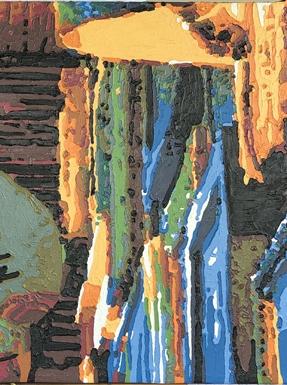 Des and Dad by Adam Sensel
Des and Dad by Adam Sensel

produced or Arshile Gorky. Altering this mindset took some time but I see it now. Maybe this is a stretch, but I have been successful in merging the real everyday scenarios with an abstracted color pallet and fluid irregular shapes. It goes deeper though with this idea of abstract and figurative. My imagery is figurative for the most part but the underlying idea of bringing the bardo out in the paintings as well as the blurred figures and exaggerated colors merge the abstract to the figurative. Love Bomb Reiteration is a great example. It’s an image captured at an amazing BBQ joint in New Orleans, with great décor filling the walls. Figuratively it is framed pictures and art on a wall with a lamp. Besides the abstraction of the colors and shapes, this
absurd unreal concept that love as a bomb is for lack of better words explosive. This is an instance where the bardo is bleeding out into reality. Just out in the open, on display for all to see. Now look at Des and Dad. This is an instance where reality bleeds into the bardo. A pretty average scene of father and daughter but in the bardo excitement and curiosity are heightened and there’s that ominous shadow that in the figurative reality sense would not
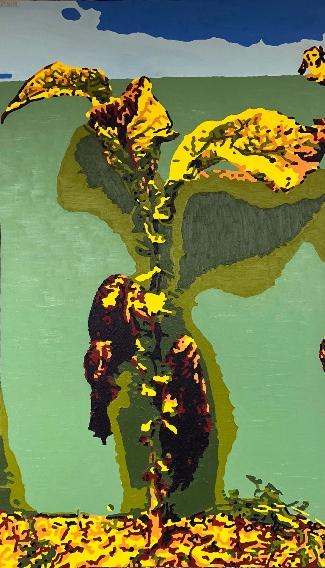
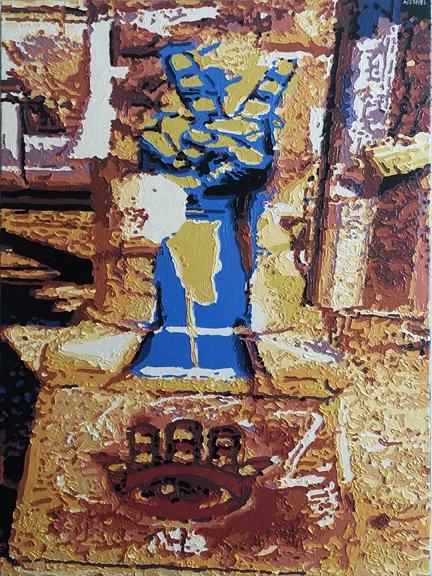
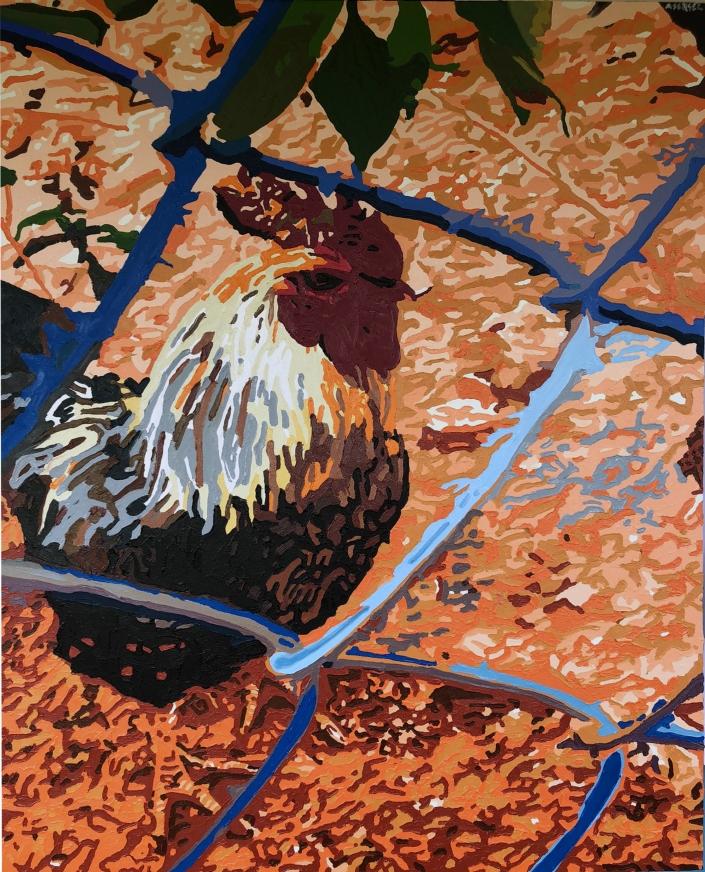
Chives
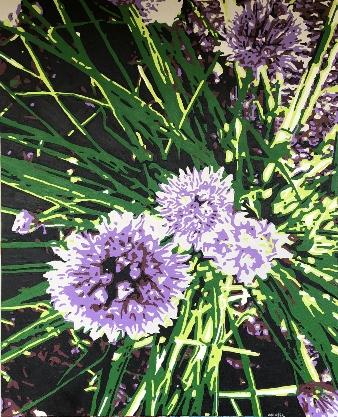
garner a second thought, in the bardo creates tension and provocation. Chains on a Tractor holds similarly to this idea of once crossed over to the bardo the figurative and abstract become merged producing new feelings. Though nothing threatening or unsettling there is a darkness to this piece amongst all its beauty. I can feel the heaviness of the chains the dirt and grime on the engine. Its all to real and yet elusive.
You are an established artist and over the years your artworks have been exhibited in several occasions, including your recent show at GreenHill, Center for North Carolina Art, Greensboro: how do you consider the nature of your relationship with your audience? Direct relationship with the viewers in a physical context is definetely the most important one,
in order to snatch the spirit of a work of Art. However, as the move of Art from traditional gallery spaces, to street and especially to the online realm — as Instagram — increases: how would in your opinion change the relationship with a globalised audience?
Adam Sensel: I believe its vital to get people in front of my actual paintings. For me its different to stand in front of Van Gogh’s Starry Night then it is to see it on a screen or in print. I am producing paintings to be out amongst the audience. I want to share with them. I want them to take a step inside the bardo from my perception of it, and maybe feel things similar to what I feel. I see our ever-expanding globalizing connection as both good and bad. I am able today to connect with people around the world and share with them my paintings and find avenues for shows, but it’s a slippery slope because it is never as good as the real in person thing.
We have really appreciated the originality of your artistic production and before leaving this stimulating conversation we would like to thank you for chatting with us and for sharing your thoughts, Adam. What projects are you currently working on, and what are some of the ideas that you hope to explore in the future?
Adam Sensel: It was such a pleasure to share with you and talk about art. My goal for 2020 is to produce 20 paintings this year. Continuing to explore the bardo and bring it to the front of our reality. In coming years I hope to develop concepts of paintings that will challenge the traditional framing of paints and play with their spatial presence and display.
An interview by , curator and curator
Cidgy Bossuet
Lives and works in Boston, MA, USA



Cidgy Bossuet
An interview by , curator and curator
Hello Cidgy and welcome to ART Habens. Before starting to elaborate about your artistic production we would like to invite our readers to visit https://www.cidgybossuet.com and we would start this interview with a couple of questions about your background. You have a solid formal training: after having earned your Bachelor of Fine Arts in Photography from the Massachusetts College of Art and Design, Boston: how did those formative years influence your evolution as an artist? Moreover, how does your cultural substratum address the direction of your current artistic research?
Undergrad definitely influenced my evolution as an artist by exposing me to multiple art techniques throughout my creative process and overall craftsmanship. Specifically, I think back to my freshman year of undergrad. During my first year, I completed a Studio Foundation program which students are required to complete before committing to a desired major. The program allows students to explore/ experiment with multiple art forms such as drawing/ painting, visual language (2D, 3D, 4D work) and form study courses.
This still plays a huge role in my creative process today- sometimes I strictly work with digital images and other times I like to experiment and combine a variety of art mediums/ materials. These include wood,
aluminum, glass, digital composites, acrylic paint and watercolor etc. The Studio Foundation program was vital for me because it gave me the opportunity to develop goal setting and independent work habits, study observation thinking in 2D- 4D practices and develop concept/ imagery skills.
The body of works that we have selected for this special edition of ART Habens and that
Cidgy Bossuetour readers have already started to get to know in the introductory pages of this article has at once captured our attention for the way it celebrates black identity, as well as the way the images that you capture counterbalance subjectivity and offers an array of meanings to the viewers: when walking our readers through your usual setup and
process, would you tell us how do you develop your ideas? In particular, do you think that your being a woman provides your artistic research with some special value? When it comes to the development of my work, I think I’m always subconsciously thinking of my overall goal/ theme. Essentially, representation is important to me so the goal

of my work is to highlight black identity/ culture and experiences- which range from artwork that simply celebrate beauty and to some that explore topics/ issues that I desire to address. With this in mind, some of my ideas come to me vividly and other times I find myself creating as I go.

Specifically, once I narrow down and commit to an idea, I expand my thoughts and jot down notes in my journal. I then create a sketch of the potential final piece or directly start my creative process in Photoshop (if it’s a digital composite piece).
In terms of whether being a woman adds a special value to my artistic research, it
depends on the topic. For instance, my work that focuses on the correlation between identity and the history of black women- hair, I think being a woman does provide special value because I can connect on a personal level. This is a topic I relate to and have experienced.
Your artworks seem to be meticulously structured. New York City based artist Lydia Dona once stated that in order to make art today one has to reevaluate the conceptual language behind the mechanism of art making itself: how do you consider the relationship between the necessity of scheduling the details of your works and the

need of spontaneity? How importance does improvisation play in your workflow?

I think having a balance of both are important. When I want to address/ explore specific topics I tend to plan out the details. For example “Roots” was a vivid thought, I knew exactly what I wanted to create. Afro’s
became a powerful political symbol that reflected African Ancestry pride, so I wanted the image to speak to that. However, improvisation is a very important part of my workflow. In fact, one of my favorite ways to create is by being experimental. I love how working spontaneously has so many outcomes, it’s a
constant build of layers.
There are moments when my planned ideas transform into completely different pieces and become exploratory- eventually resulting in some of my best work.
We have really appreciated the way you capture the inner identity of your characters: what’s your philosophy on the nature of portraiture? How do you select the people that you decide to include in your artworks?
Portraiture allows for educative content/ exploration of issues that are important in society. I value portraits so much because it’s one of my outlets that I use to express some thoughts that I can’t completely explain verbally- I find it easier to convey messages through portraiture.
I have two processes when selecting my subjects for my photography and digital composite work. With my photography, when I initially complete a moodboard, I usually look for interesting subjects that may work with my idea or I build an idea around a potential muse that I come across on social media. When creating my characters for my digital pieces I either use my portraits as reference or stock images.
Mexican artist Gabriel Orozco once remarked that "the artist’s role differs depending on which part of the world you’re in. It depends on the political system you’re living under":
does your artistic research respond to a particular cultural moment? In particular, how



does everyday life's experience fuel your artistic research?
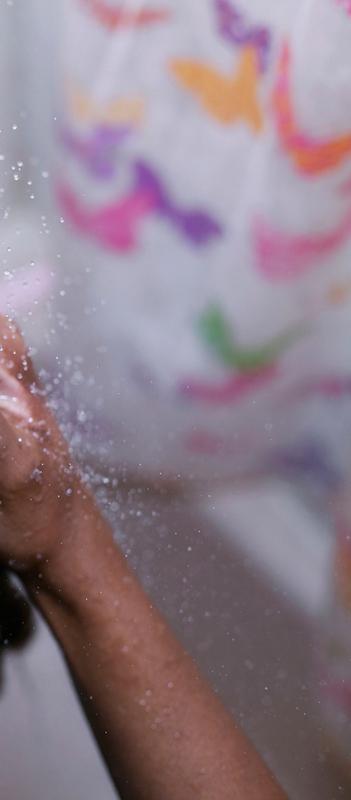
Initially, my decision to focus on black identity started my junior year of undergrad. I created a series called Nappturality, which specifically focuses on the political issues of black women’s natural hair. I explored subjects from the negative connotations associated with natural hair throughout history to the impact/ symbolism of the afro during the Civil Rights Movement.
This topic is continuously evolving so I tend to observe the shifts that are happening in todays society. For instance, a law that was recently created to ban policies that penalize black people for wearing natural curls, locs, twist, braids and other natural hairstyles- which is slowly but surely being passed within certain states in the U.S. This is bitter-sweet because it’s crazy thinking our hair/ texture is still an issue today- it makes me question why it took so long and or why we still face hair discrimination.
I’m constantly fueled by stories or articles I hear about, which impact my artistic research. For example, Deandre Arnold, a student in Texas that was suspended because his high school said his dreadlocks violated its dress code. He was left with an ultimatum, to cut his dreads or he wouldn’t be able to participate in his highschool graduation. Hearing stories like this is upsetting and brings me back to reasons why I created Nappturality, and constantly creating pieces that celebrate black identity.

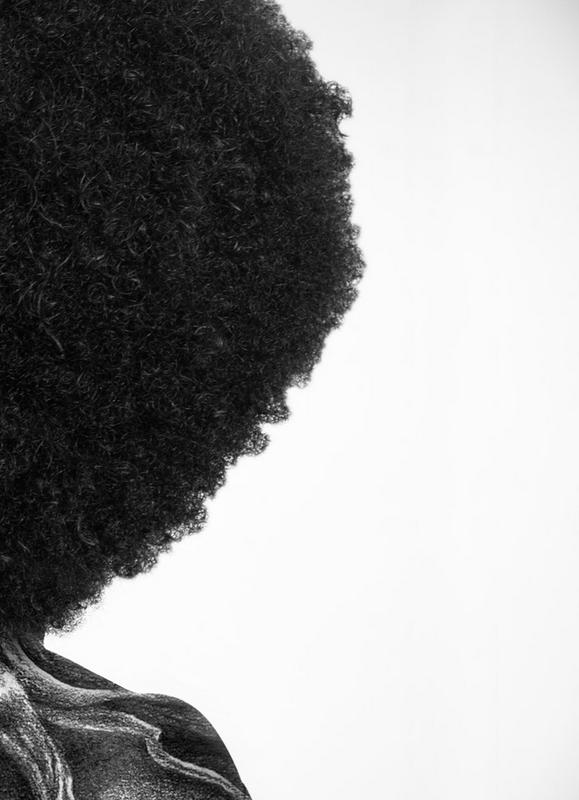
You are a versatile artist and over the years you have been experimenting with different modes of photography, including appropriated images
and digital imaging: how do you consider the role of digital technology playing within your work?

Creating digitally allows me to project my imagination instantly. If it wasn’t for digital technology, I’m not sure how I’d be able to create
some of my ideas. I think it’s one of the reasons I started incorporating digital composited images with my work. I’m able to

release my ideas digitally, create spontaneously then figure out how to bring them to life with my other art forms or let them live digitally.
In a controversial quote, German photographer Thomas Ruff stated that ''nowadays you don't have to paint to be an artist: you can just create

photographs in a realistic way".
Provocatively, the German photographer highlighted the short circuit between the act
of looking and that of thinking critically about images: how do you consider the role of photography in our contemporary age,

constantly saturated by ubiquitous images?

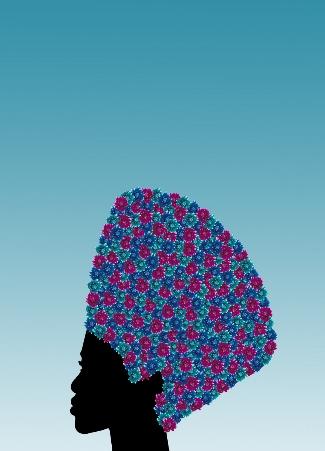
It has become so accessible, so I understand how it can get saturated. Photography will continuously be considered to have a special status for recording the world. It serves as a tool to capture motion, document a split-second of time, construct history, memory truth and identity.
With photography being digital for some time now, it’s becoming part of our daily lives especially with social media in this day and age. Due to access, I feel like most people are making
it a point to document their lives often to have an archive/ physical memories to hold onto.
You are an established artist and over the years your artworks have exhibited in several occasions, including your recent participation to the group exhibition Slideshow, at Roman Susan Gallery, in Chicago, as well as to the PULSE Contemporary Art Fair (Miami) and Enlightened: Contemporary Photography Exhibition at the YoungArts Gallery (Miami): how do you consider the nature of your relationship with your audience? Direct relationship with the viewers in a physical

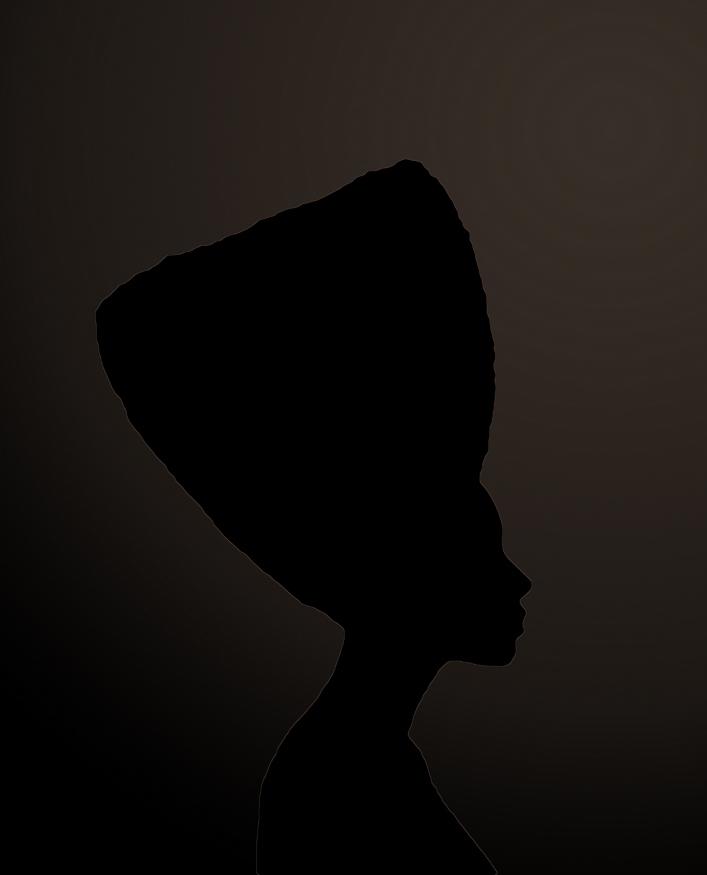
context is definitely the most important one, in order to snatch the spirit of a work of Art. However, as the move of Art from traditional gallery spaces, to street and especially to the online realm — as Instagram -> https://www.instagram.com/ciciboss — increases: how would in your opinion change the relationship with a globalised audience?
I would say that I’m still an emerging artistalthough I’ve caught the eyes of a selected few curators/ organizations, I’m still working towards establishing a solid career/reputation as a visual artist/ photographer.
I do agree that direct relationship with the viewers in a physical context is important. Seeing artwork in person, allows the viewer to grasp all the details of a piece. Although, art living in the online realm is just as important to reach a larger audience. Online, I’m able to get direct feedback in real time on my work, which I appreciate.
We have really appreciated the originality of your artistic production and before leaving this stimulating conversation we would like to thank you for chatting with us and for sharing your thoughts, Cidgy. What projects

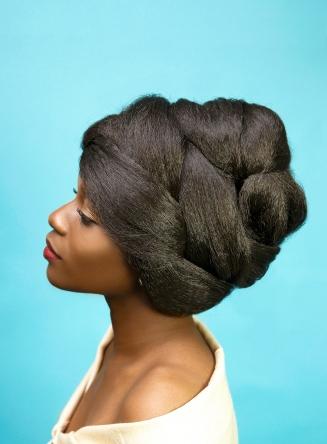
are you currently working on, and what are some of the ideas that you hope to explore in the future?
I’m happy to be granted the opportunity to share my artistic process!
I’ve also been working on a collection of portrait and abstract paintings- these pieces are primarily spontaneous and I find myself exploring textures, form and colors.
Some ideas I hope to explore in the future- I would say more structural pieces. I think it
would be visually appealing to see some of my ideas live 3 dimensionally and would give the viewer a different experience when being exhibited. Specifically, I would like to create a body of work that resonates with children or evoke childhood memories yet still ties to black identity, as representation is vital to me.

An interview by , curator and curator
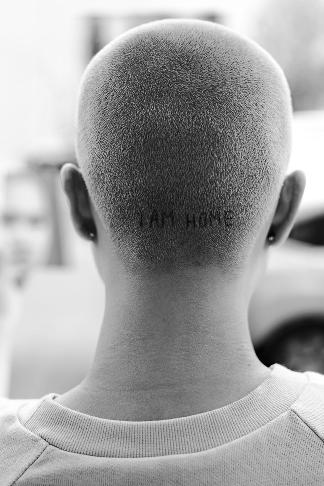

Lives and works in Ha Noi,Viet Nam

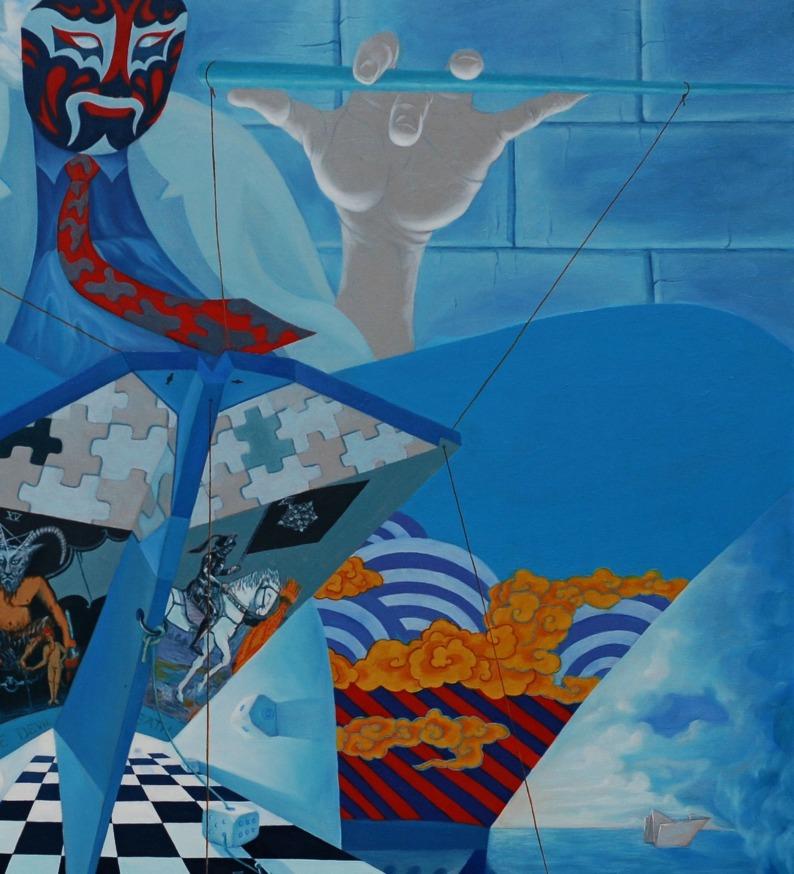
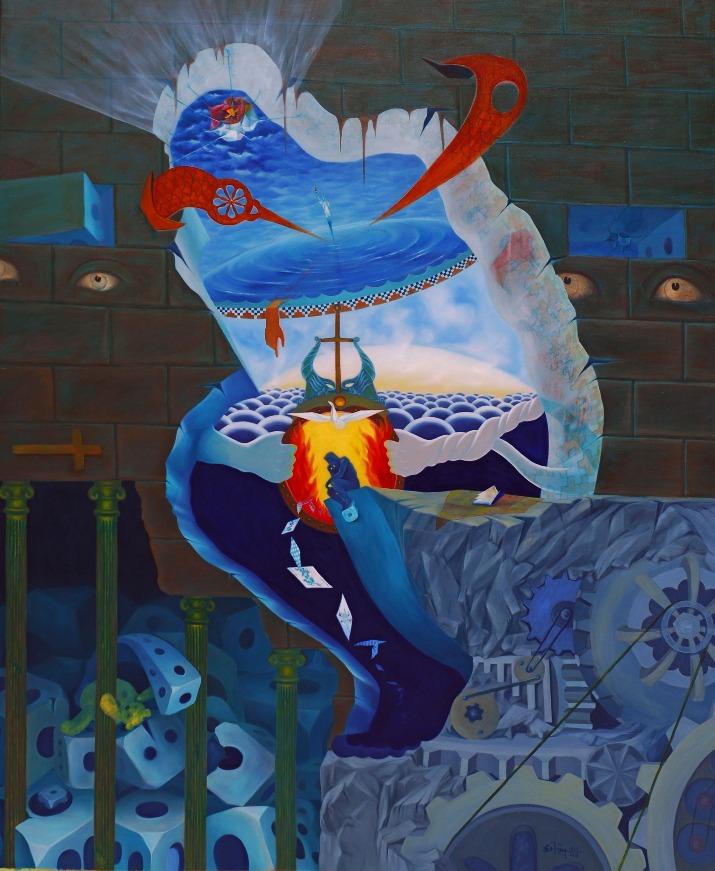
Hello Dam Lan and welcome to ART Habens. Before starting to elaborate about your artistic production we would like to invite our readers to visit http://www.tungat.com and we would start this interview with a couple of questions about your background. You have a solid formal training and you Graduated from Vietnam Fine Arts University: how did these formative years influence your evolution as an artist? Moreover, how does your cultural substratum due to your Vietnamese roots direct your current artistic research?
Dam Lan Tung: I graduated from Vietnam Fine Arts University where trained me the basics knowledge of fine arts by respected lecturers. They are really the mirror in art creativity. And art is always transformable. That’s what I have learned from my respected teachers and in the studying environment which is the valuable things and direction in my artwork orientation. And I know what I need to do.
I’m Vietnamese, the next generation , to preserve and develop Vietnamese culture which is the foundation of my spiritual life and has the huge influence on my art trend. Though modern art is a mixed-up among lots of trends of the world, my artwork has
been built in terms of indigenous spiritual culture. Vietnamese culture is unique and my art projects and artworks’ ideas base on a common aspect. My artwork also comes from the personal aesthetics based on the foundation of space, time, the concept of freedom, culture... which was built on the perspective of Vietnamese culture, Eastern culture.
 Dam Lan Tung
Dam Lan Tung
Marked out with such unique visual identity, the body of works that we have selected for this special edition of ART Habens, and that our readers have already started to get to know in the introductory pages of this article, has at once captured our attention for the way you use your visual language in such strategic way to counter-balance subjectivity, offering an array of meanings to the viewers and highlighting the connection between direct experience and imagination. When walking our readers through your usual setup and process, would you tell us how do you usually develop your initial idea for your artworks? Do you create your works gesturally, instinctively? Or do you methodically transpose geometric schemes?
Dam Lan Tung: As in the introduction I have mentioned the influence factors to my artistic development trend, up to the present. Among them , freedom is the most highlighted viewpoint :physical freedom, spiritual freedom, cultural freedom... The concepts of freedom lead my thoughts to the generalized images of the past, present ... and based on ideology of the Eastern conception, the appropriate space will be used for each of my artwork’s idea.
To my point of view, the converting method from instinct (inherent and cumulative) to geometric plan is indispensable in creation.
The artist has to transform the invisible things to visible selectively and aesthetically, perform the artwork’s idea to interact with the audience. And that is how I made my own artwork.
Think about the thinker features such superb combination of light and dark tones, that create tension and sense of dynamism: how did you come about settling on your color palette? And how does your own psychological make-up determine the nuances of tones that you decide to include in your artworks?
Dam Lan Tung: During the time I worked on the painting "Think about the thinker", there is one thing that interested me. I mean, the more advanced state the human society reaches, the easier it is for us to realize that there are two sides of a coin in everything, like yin and yang, sorrow and joy.
In term of freedom, even when you find yourself living in freedom, you're not completely free, you have to be in a state of being restrained to pay a price for freedom. That's why I opted for the idea of "Think about the Thinker" - a combination of opposite states, i.e "light - dark", "voidfulfiled". To me, what I want to convey is that it is a way we advance our thinking about life and human society.
We have really appreciated the way your artistic practice embodies an interface
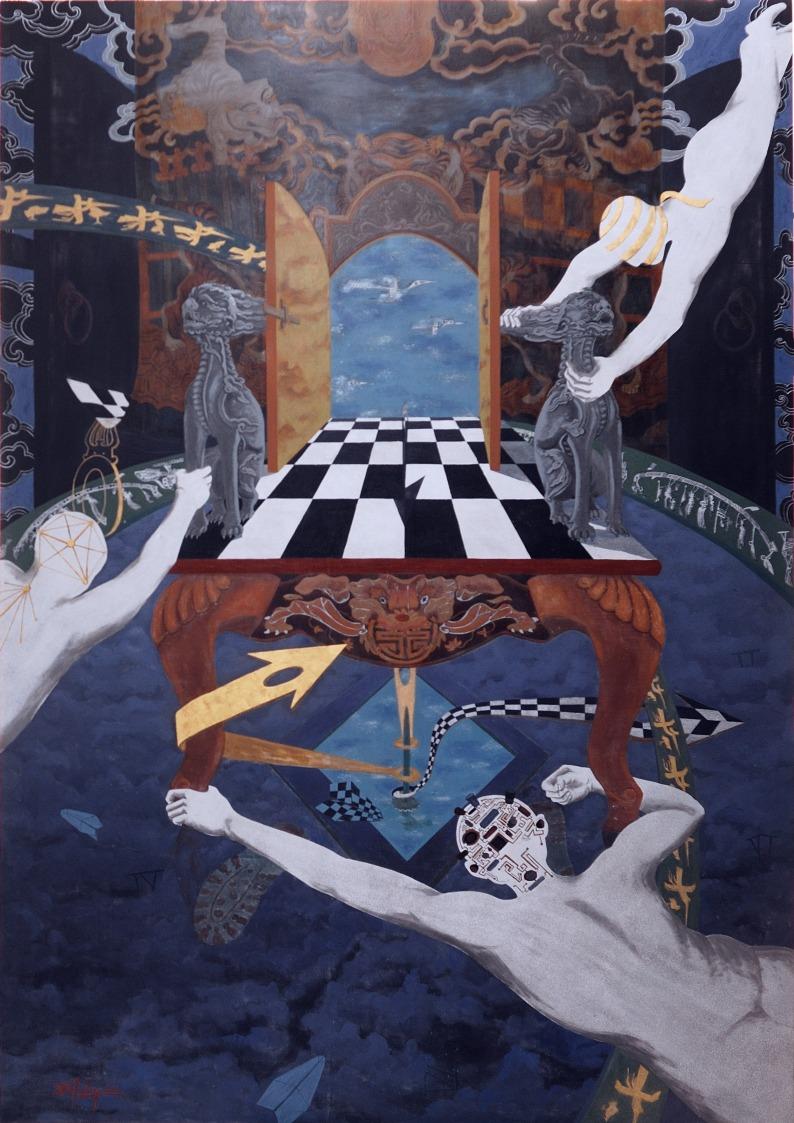 The culture covenant, lacquer painting, 120x180cm, 2016
The culture covenant, lacquer painting, 120x180cm, 2016
 Conception of time, oil on canvas, 200x150cm, 2017
Conception of time, oil on canvas, 200x150cm, 2017
between the real and the imagined, and we have been struck with the way The dream is not in tune unveils the link between reality and the dreamlike dimension: how do you
consider the relationship between reality and imagination playing within your work as an artist? And how does your everyday life's experience fuel your artistic research?
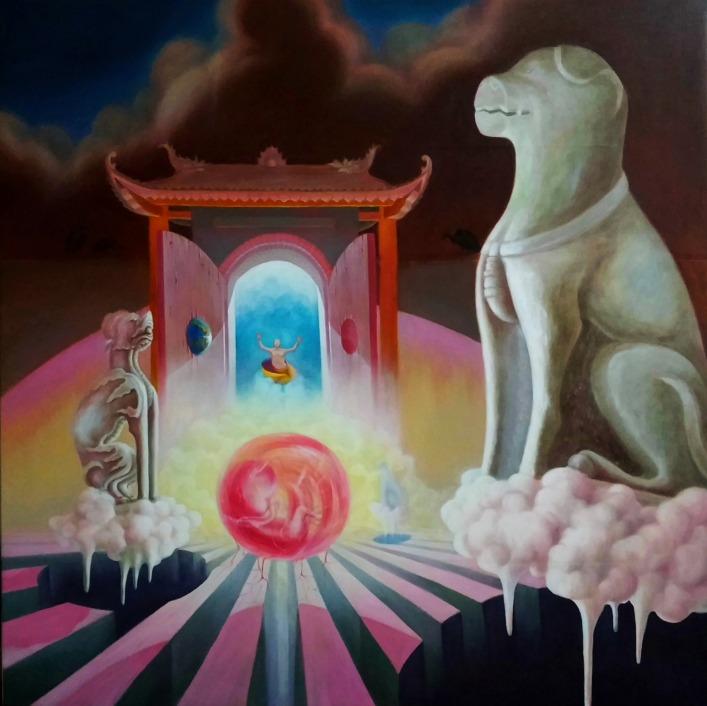
Dam Lan Tung: Our reality and our dreams are always two separating concepts. The reality is a reflection of social impacts, emotional effects ... on human
relationships, whereas dreams are what people want to make up for the shortcomings, fill the void in the soul ... "The dream is not in tune" is a part of my
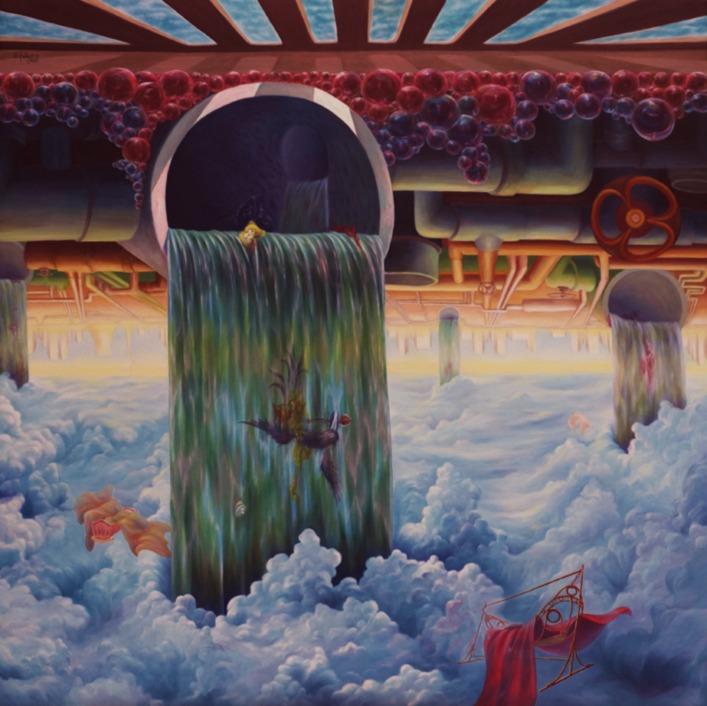
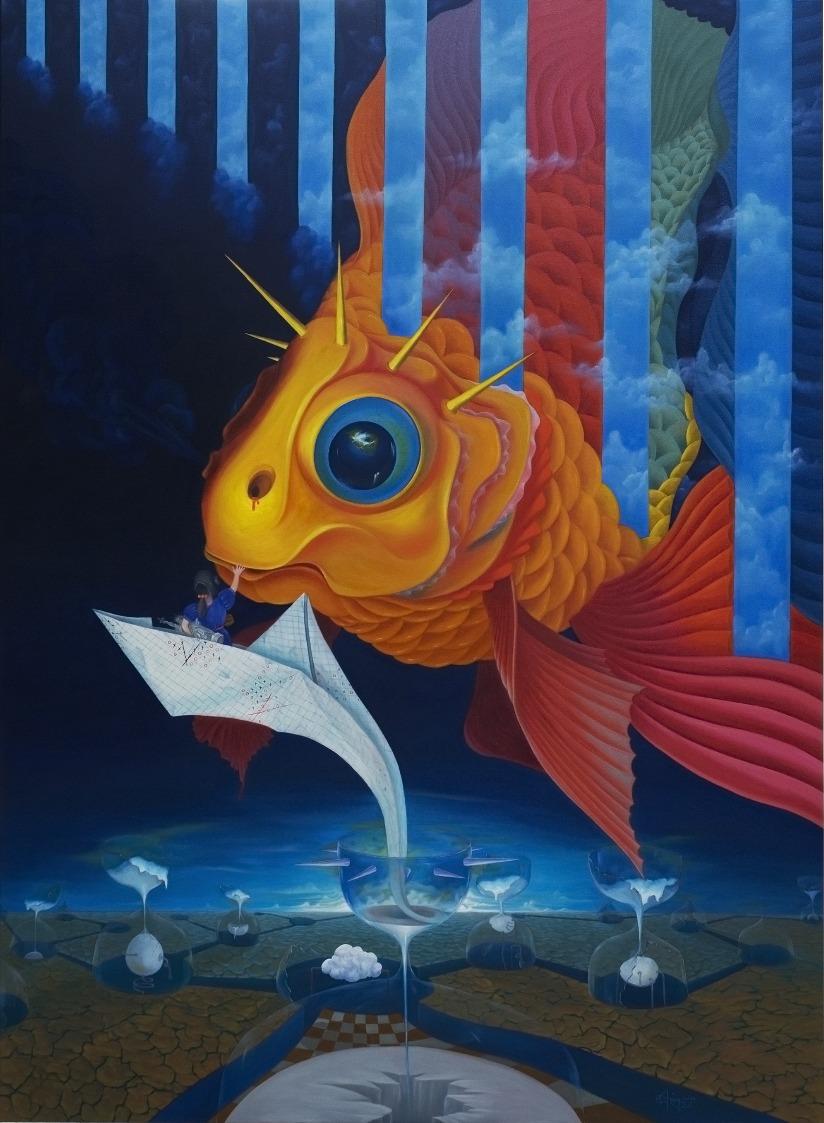 Dream of Goldfish 1, oil on canvas, 200x150 cm, 2018
Dream of Goldfish 1, oil on canvas, 200x150 cm, 2018
inheritances - oil on canvas -120 x 80 cm - 2017

personal life. Unfinished wishes. Stolen hopes. In my artwork, I combine opposing spaces, contrasting factors to create a metaphorical "reality - virtuality" mixture.
I think all studies of art are based on culture, time and sentiments ... I am living in a vibrant, diverse society. The thickness of national culture is the foundation of my life.
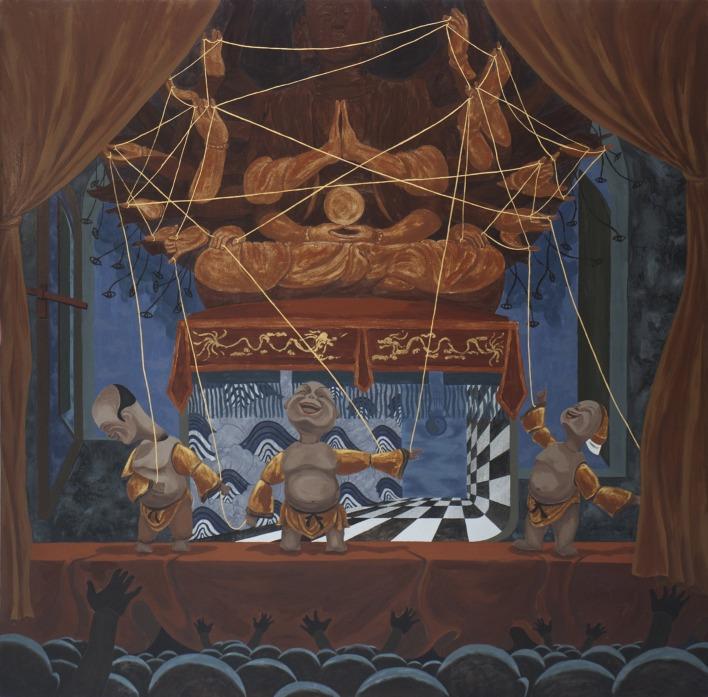
Mission, oil on canvas, 100cm x 100 cm, 2017
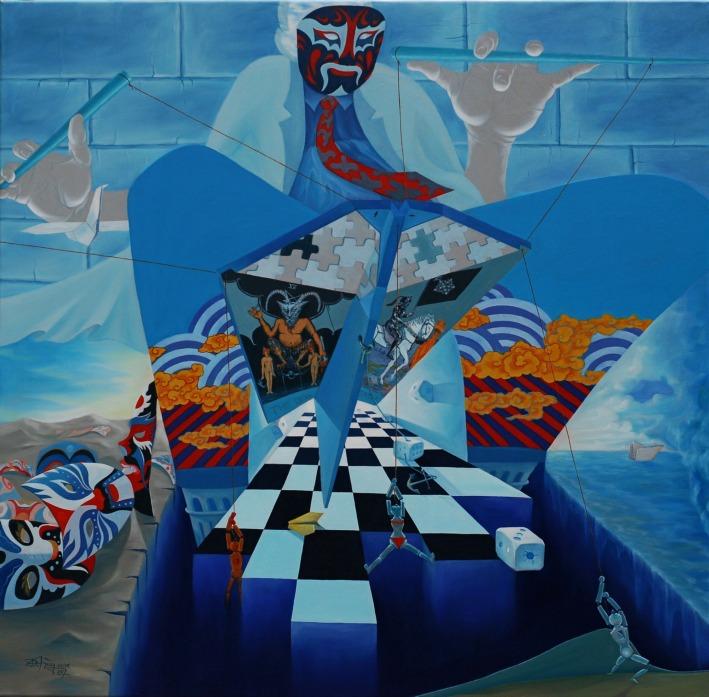
What called "to gain - to lose", "to live - to die"... reflects the defect level of the civilization. It gives me more or less an
objective look to recreate and re-anticipate in visual language.

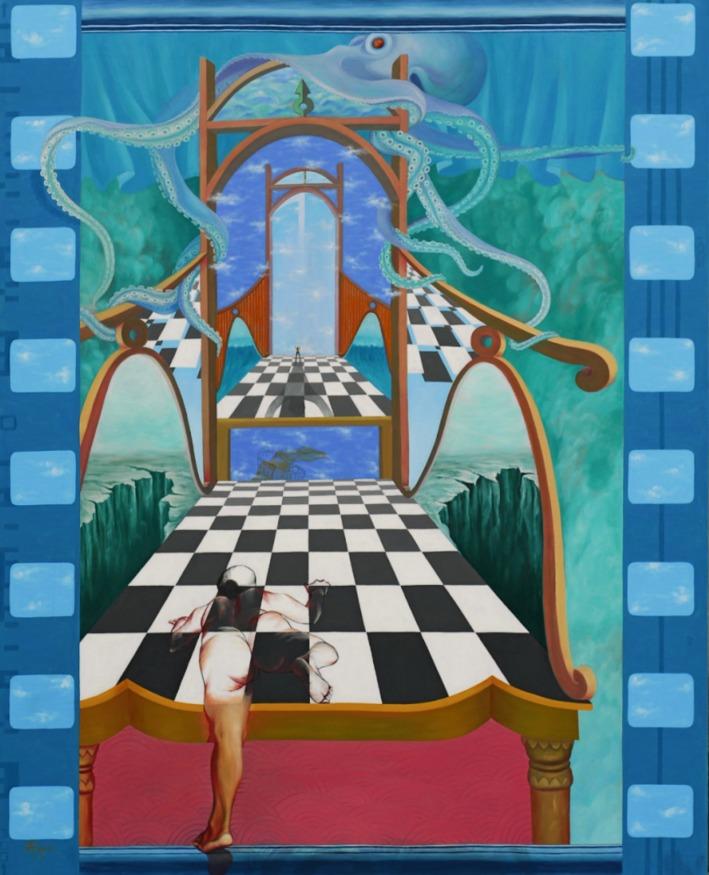
Your artworks, — as the interesting Concept orientation and Search — features geometric chequered patterns, that working on both a subconscious and a conscious level, give rise to such epiphanic experience in the viewers: why do you include such chequered geometries in your artworks and how important are symbols for you?
Dam Lan Tung: The motif I have used a lot of is the geometric chequered patterns. It is highly conceptual. In the Eastern culture, it shows the duality: "black - white, rightfalse, light - dark, negative - positive ...". When placed in a metaphorical context, it will awaken and transform the view of each viewer. When it comes to a problem, it also stimulates aesthetics and gives rise to new ideas.
With their unique multilayered visual quality, the figures in your paintings are often blurred and merge into their surroundings — as in the interesting Concept orientation — and seem to invite the viewers to look inside of what appear to be seen, rather than its surface, providing the spectatorship with freedom to realize their own perception. Austrian Art historian Ernst Gombrich once remarked the importance of providing a space for the viewers to project onto: how important is for you to trigger the viewers' imagination in order to address them to
elaborate personal interpretations? In particular, how open would you like your works to be understood?
Dam Lan Tung: To my viewpoint, an artwork, apart from providing audiences the aesthetics, it is necessary to interact with them, bring them ideas, thoughts, feelings ... of the author . And, there are the suggestion for them to explore and go into the artwork to find their own views, affecting their subjective feelings. And that's what I always want to include in my artwork. And to do that, my personal side has been greatly influenced from the concept of Eastern culture. Use images, language, space to express ideas and intentions hidden deep in it .That's how I want to lead viewers to discover my artwork.
Your artworks have a very distinct visual identity and you often create large canvas, that provide the viewers with such an immersive visual experience: how do the dimensions of your canvass affect your workflow?
Dam Lan Tung: First, my artwork has not been affected by the size of the painting. It will be best suitable when I take initiative in ideas and drafting. For the large canvas sizes, I target to bring better visual effect to the audience, and it also has enough space for me to develop the idea.
Over the years your artworks have been internationally exhibited in several occasions: how do you consider the nature of your relationship with your audience? Direct relationship with the viewers in a physical context is definetely the most important one, in order to snatch the spirit of a work of Art. However, as the move of Art from traditional gallery spaces, to street and especially to the online realm — as Instagram — increases: how would in your opinion change the relationship with a globalised audience?
Dam Lan Tung: In composing, I am completely subjective individuality. In each of my artwork, I would like to deliver to the audience a different aesthetic perspective, different perspectives. And I did not choose the compose according to the taste of the majority of audiences. From domestic and international exhibitions, I always want my work to be able to interact with the viewer despite the cultural differences. With the online network trends, Instagram has increased significantly, the audience's access to art is extremely convenient and diverse. However, that will decrease the core value of real art work. Audience will lose the real vibe in the soul before each of their favorite works.
We have really appreciated the originality of your artistic production and before leaving this stimulating conversation we would like to thank you for chatting with us and for
sharing your thoughts, Dam. What projects are you currently working on, and what are some of the ideas that you hope to explore in the future?
Dam Lan Tung: I'm working on projects for solo and group exhibitions in 2021, 2022, and some other sculpting plans. In addition to current ideas, in the near future, I intend to expand more ideas on social aspects, philosophical thinking approaching contemporary society.


Lives and works in Guelph, Ontario, Canada
Larissa Monique Hauck is a queer emerging visual artist that graduated from the Alberta University of the Arts in 2014, where she received a BFA with distinction. Many of her artworks have been featured in regional and national group exhibitions as well as a growing number of international exhibitions. She has been selected for inclusion in events such as Nextfest 2018 (Edmonton, AB), Nuit Rose 2016 (Toronto, ON), and the 9th Annual New York City Poetry Festival 2019 (New York, US). Her drawings and paintings have also been featured in publications such as Creative Quarterly (US), Wotisart Magazine (UK), Minerva Rising (US), and various others.



Larissa Hauck
An interview by , curator and curator
Hello Larissa and welcome to ART Habens. Before starting to elaborate about your artistic production we would like to invite our readers to visit https://larissamoniquehauck.com and we would start this interview with a couple of questions about your background. You have a solid formal training and you hold a Bachelor of Fine Arts With Distinction, that you received from the Alberta College of Art and Design (Calgary, AB, Canada): how did those formative years influence your evolution as an artist? Moreover, how does your cultural substratum direct the direction of your current artistic research?
Larissa Hauck: Hello! Thank you for having me. Before I made the choice to attend the Alberta College of Art & Design (ACAD), I discovered my interest in visual art from my grandma as she was a painter and was always telling me stories about old paintings and artists. Once at ACAD I was fully immersed in contemporary art, which was another experience all in itself. Art began to unfold and expand before me as something beyond my initial idea of it. I spent the majority of my time in the studio, painting and creating as much as possible whenever I could. I tried a few different mediums and styles while in school… but at the end of the day I always felt the most at home with a brush in my hand, and I believe that why I have stayed true to my traditional roots. Painting has taught me there is always a new way of seeing, if something is not working one way there is always a different angle to try.
Marked out with such unique visual identity, the body of works that we have selected for this special edition of ART Habens —and that
our readers have already started to get to know in the introductory pages of this article — has at once captured our attention for the way you use your visual language in a strategic way to question the fleeting aspects of time and permanence, and offering an array of meanings. When walking our readers through your usual setup and process, would you tell us how do you usually develop your initial idea for your portraits? Do you create your works
Larissa Hauckgesturally, instinctively? Or do you methodically transpose geometric schemes?
Larissa Hauck: Oh wow! Many ways… all of the above really! A lot of my artwork comes
from an initial feeling, an urgency to create during a time of emotion. Sometimes I will start with automatic writing and will pull out words that speak to me at the time. Other

times I will just start drawing with a pen, so I cannot change what I have done, and allow my mind to truly wander. I think about moments in my life where I have felt
powerless and what emotions have risen from that, or monumental events that have shaped who I am today. I find I cannot work the same way for each artwork, I seek

inspiration in the everyday and when the need to create arrives… it arrives!
We have appreciated the delicate, thoughtful nuances that marks out your artworks, and that draw the viewers to a state of mind where the concepts of time and space become suspended. How does your own psychological make-up determine the nuances of tones that you decide to include in an artwork and in particular, how do you develop your textures in order to achieve such unique results?
Larissa Hauck: I have always been drawn to the weird and unexplained in life, whether it is a passing feeling or an experience I tend to hone into those areas of curiosity. As a kid I was fascinated by old ghost stories and fables, basically anything that had a hint of adventure to it. Since I grew up in a small town it was easy to feel isolated or out-casted if your interests did not align with the rest, so I found myself turning inward and towards visual art. I think it would be wrong to assume I don’t pull from areas of my life, as I believe art can be a reflection of the individuals experience regardless if intended or not.
I like to give my drawings the space to breathe between layers, and I think this helps with the gestural mark-makings of the colours. Sometimes I will wait a day between layers to give myself time to really sit with the work.
Pervaded with such captivating dreamlike ambience, your artworks have struck us for the way you combine reminders to human figure and environmental reminders, as in the interesting Wonderland. Scottish painter Peter Doig once remarked that even the most realistic paintings are derived more from within the head than from what's out there in front of us: how do you consider the relationship between reality and imagination, playing within your


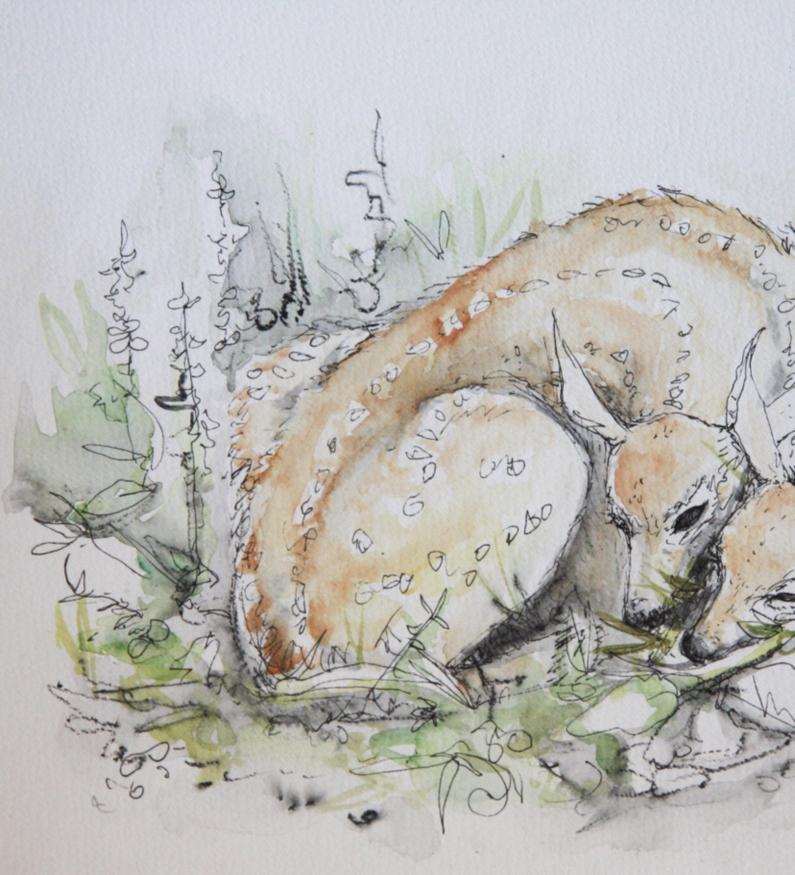
artistic production? In particular, how does everyday life's experience fuel your artistic research?

Larissa Hauck: I find that inspiration works best when it is not forced, especially during those moments of in-between and reflection. When we are stuck in traffic or between shifts and we allow ourselves to stop and observe all that is really around us. Humanity is full of inspiration, with the hustle and bustle of the everyday we can sometimes overlook it but, for me, it is important to take a step back and remember that we are living, breathing, sources of life and beauty that should be treated as such.
To create your hybridized creatures, you draw from mythology, and we appreciate the way you sapiently you re-elaborate figures belonging to universal imagery, as unicorn and anthropomorphic animals in the service of your unique contemporary sensitiveness. You seem particularly interested in exploring symbolic themes stemming from ancient cultures to the present: w do you consider the relationship between the cultural heritage from traditional cultural heritage and contemporary sensitiveness, in order to explore the themes of vulnerability and unconsciousness?
Larissa Hauck: I believe these are themes that are ever-present in us, we act as if we cast away old rituals and past superstitions with ease but in reality there are many ways in which we as a collective have not strayed from the traditional. There is something to be said of our romanticization of the planets and elements, how quickly we listened to tales of human punishment and redemption at the hands of the Old Gods. I question whether these are characteristics that are ever-present
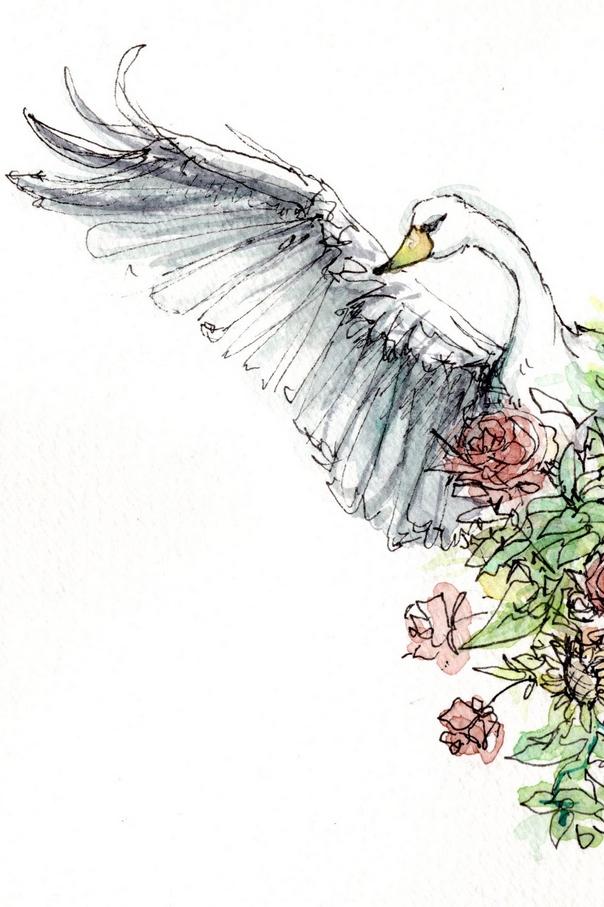

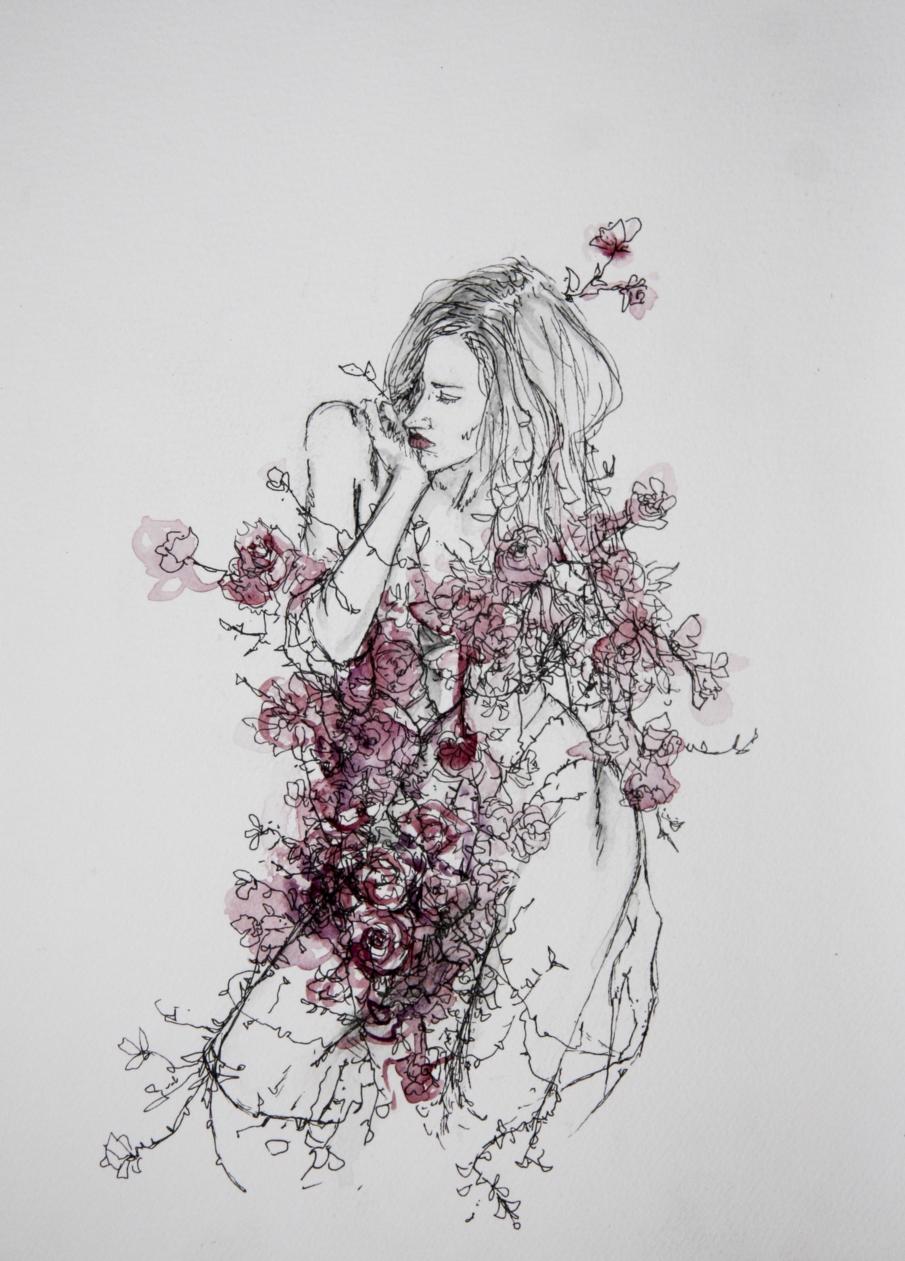
within us or if they are just something we are drawn to because it feels safe.
With their unique multilayered visual quality, your artworks highlight contours of known reality in an unknown world and seem to invite the viewers to look inside of what appear to be seen, rather than its surface, providing the spectatorship with freedom to realize their own perception. Austrian Art historian Ernst Gombrich once remarked the importance of providing a space for the viewers to project onto, so that they can actively participate in the creation of the illusion: how important is for you to trigger the viewers' imagination in order to address them to elaborate personal interpretations? In particular, how open would you like your works to be understood?
Larissa Hauck: I am always conflicted with the idea that an artwork has a universal meaning. I mean, yes, there is the artist’s intent but that does not mean every single person will see that. We are all individuals and so I feel that as long as someone has a real, emotional connection with an artwork then I feel as though the work has done its job.
A particular aspect of your artistic production responds to concerns within folklore and literature surrounding femininity. Over the recent years many artists, from Martha Wilson to Carolee Schneemann have explored culture’s expectations about what women are supposed to be: as an artist interested in questioning the themes of femininity and cultural identity, do you think that contemporary art could be a conduit for a kind of social criticism in our globalized, still patriarchal societies? Moreover, do you think that your being a woman provides your artistic research with some special value?
Larissa Hauck: Since we seem to still face the same boundaries as in the past I feel that
there is a certain amount of social responsibility that falls on us as individuals, especially any that have a platform or chance to speak up.
We are quick to say things have “come a long way”, however if we really look at the current sociological make up of the world we realize how little we have progressed in this area. I believe that, as a young queer woman I am responsible for using my voice to educate others as well as standing up for people that society deems deviant or unfit. I am not sure I would go as far as saying being a woman provides me with some “special value” as an artist, but it does provide me with an insight through the lens of feminine experience.
Over the years your artworks have been featured in regional and national group exhibitions as well as a growing number of international exhibition, including your recent show Dreamwalker, at Guelph Public Library: how do you consider the nature of your relationship with your audience? Direct relationship with the viewers in a physical context is definetely the most important one, in order to snatch the spirit of a work of Art. However, as the move of Art from traditional gallery spaces, to street and especially to the online realm — as Instagram — increases: how would in your opinion change the relationship with a globalised audience?
Larissa Hauck: The audience’s ability to access my artwork is very important to me. I believe that art is for human experience and that it is created with the intent to be seen. I embrace the online realm as it has been able to introduce art to a whole new audience that otherwise might not have ever been able too. Traditional artwork exists differently online and in person, with the increase of social
No Gods
media it has made artists have to think creatively about the ways they choose to curate themselves on the web.
Because of the ease of online stores I have been able to connect with buyers from all parts of the world, which without social media I would not of otherwise been able to do on my own. I also love that even though it
is a worldwide experience, you can make very personal connections.
Feel free to check out my Instagram: www.instagram.com/larissamoniquehauck to see peeks into my studio and all the new things I have been working on!
We have really appreciated the originality of
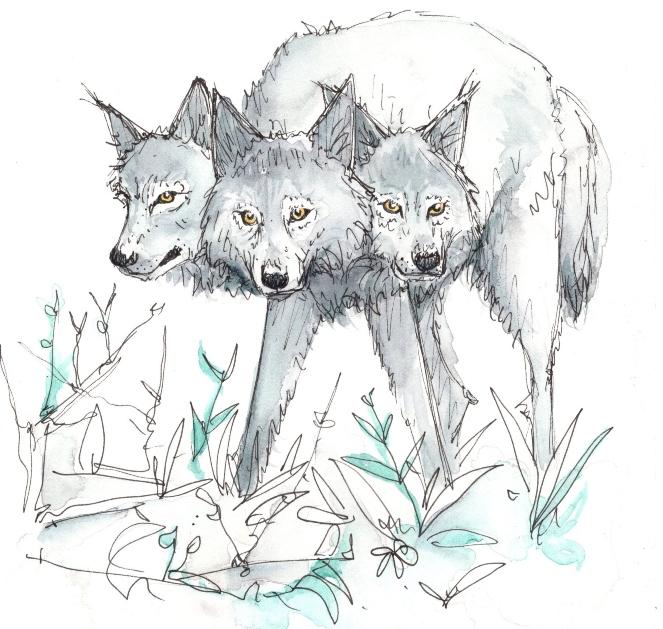


Overgrown The Edge Of Divine
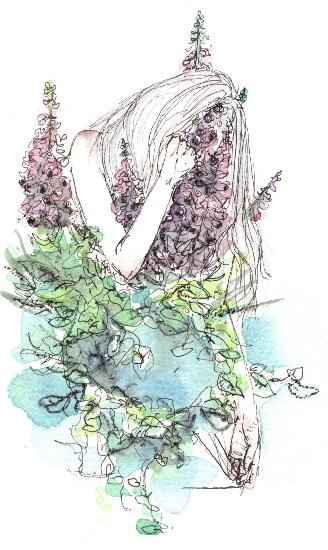
your artistic production and before leaving this stimulating conversation we would like to thank you for chatting with us and for sharing your thoughts, Larissa. What projects are you currently working on, and what are some of the ideas that you hope to explore in the future?

Larissa Hauck: More paintings! I have finally made a huge return to painting after only drawing for the past 3 years and so you can certainly expect to see some peeks of those soon. (Especially on my Instagram!)
Honestly, I have many new things brewing in my studio and some of which are in the very beginning stages and I am not quite ready to talk about them yet… Let’s just say that this is just the start of what I hope to produce and achieve throughout my artistic career. I am ready to let my vision unfold!
An interview by , curator and curator
Lives and works in Nice, France


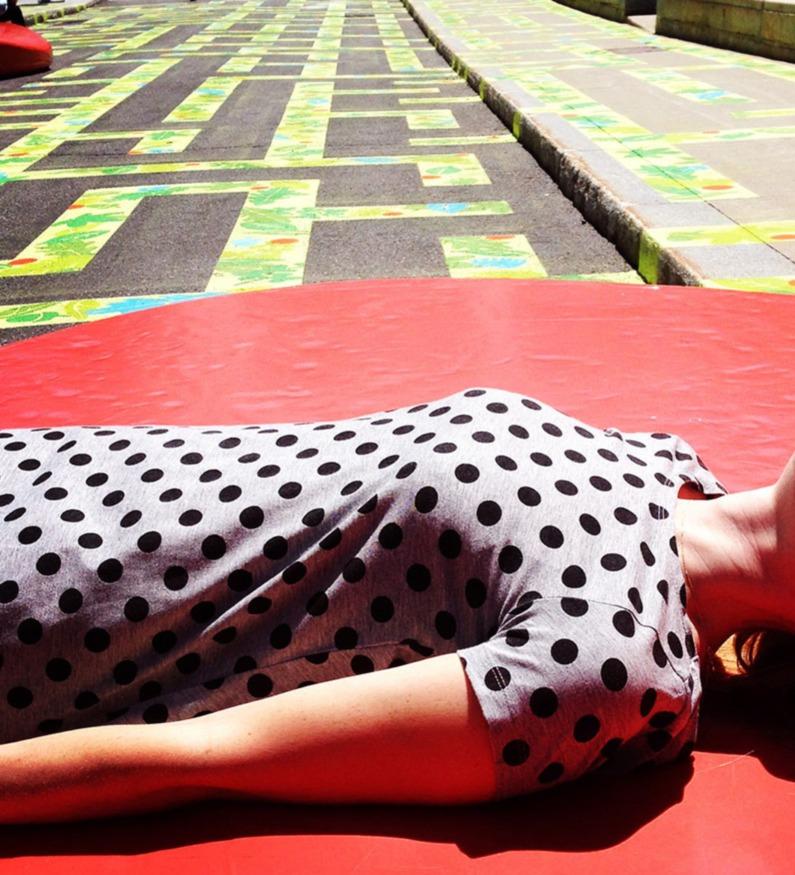
Hello Dominique and welcome to ART Habens. Before starting to elaborate about your artistic production we would like to invite our readers to visit http://www.dominiqueczerednikow.com and we would start this interview with a couple of questions about your background. As a selftaught artist, are there any experiences that did particularly influence your creative process and help you to experiment? Moreover, are there any experiences that drive your inspirations and aspirations?

Dominique Czerednikow: As a self-taught artist I have been most lucky to freely develop my passion and artist education through forged life experiences and experiments. Over the past 10 years I have matured my style and built my artist education. I have taught myself oil painting, studied the museums of Europe, lived abroad in West Africa and learned the new technologies of North America.
Having the opportunity to live in several very different countries and cultures has shaped my spirit and influenced my art. I am constantly pushing boundaries, exploring new worlds and new feelings. My art is my sanctuary. No matter where I go I have it with me.
Marked out with such unique visual identity, the body of works that we have selected for this special edition of ART Habens —and that our readers have already started to get to know in the introductory pages of this article — has at once captured our attention for the way you use
your visual language in a strategic way to counter‐balance subjectivity, offering an array of meanings. When walking our readers through your usual setup and process, would you tell us how do you usually develop your initial idea for your artworks? Do you create your works gesturally, instinctively? Or do you methodically transpose geometric schemes?
Dominique Czerednikow: Painting feeds my soul, emotions and impressions. When I am creating all my energy is converted to colours and abstract forms more or less geometrical. I am always looking to recreate the beauty that I see and feel.
My process requires patience and concentration. I love pulling elements from my inspirations and working them into shapes and colourful spaces. Swirls, dots, curls and lines add elements of depth and excitement. My imagination guides me in my colour choice and composition. In each painting I work toward a greater harmony.
The works selected for ART Habens are a part of my collection Inspiration from the Masters a project that results in a series of variations based on themes from the masters of the past that are truly inspiring.
Your artworks often feature bold and vivacious tones that provides Citrus and Orchid with such sense of dynamics. How does your own psychological make-up determine the nuances of tones that you decide to include in your artworks?
Dominique Czerednikow: I am an introvert. I speak through my art by transferring my genuine feelings to my canvas. As an artist, art lover and art ambassador the idea behind my work is to share these strong sensations. Being surrounded by bright alluring colours can influence our way of being and way of life. Colours nurture our

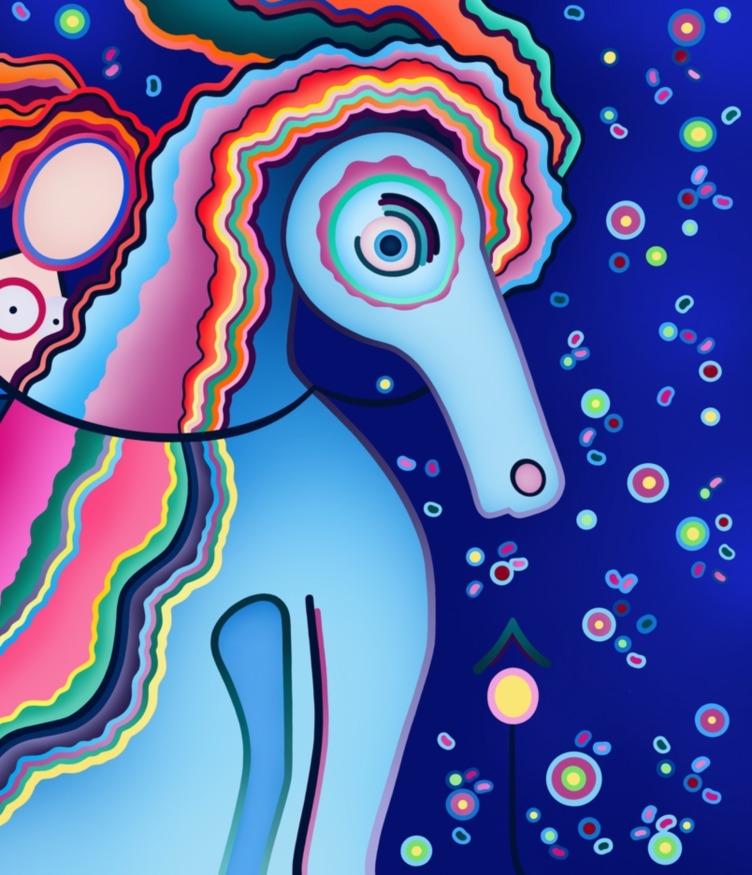
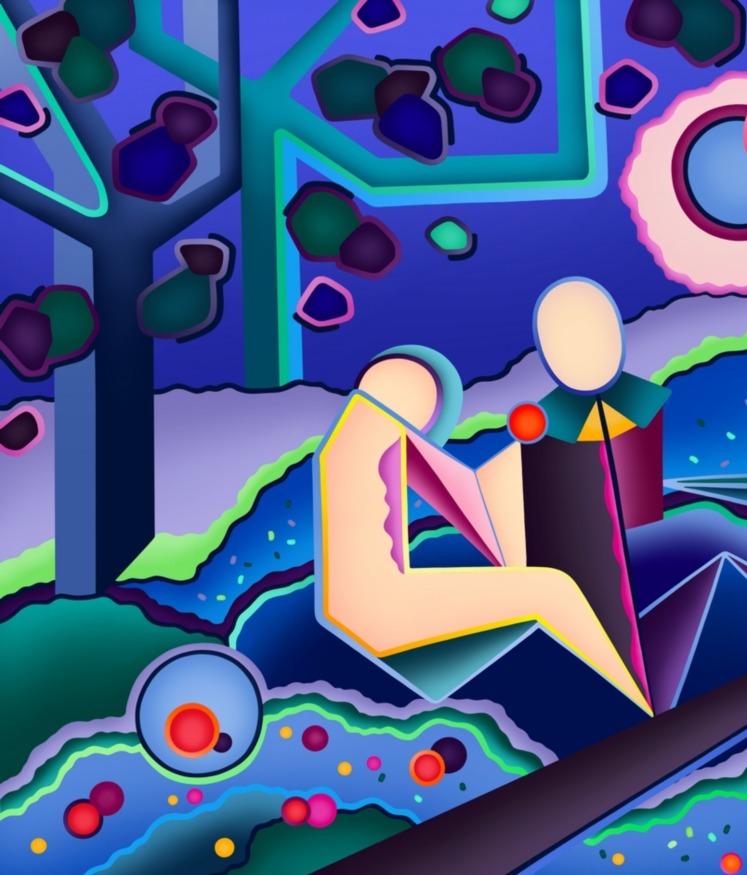
spirit and give us energy. The feeling of losing oneself in a work of art is a human necessity.
We dare say that each painting of yours is a separate world that the viewers are invited to explore, receiving such strong sensations of life: how does everyday life's experience fuel your artistic research?
Dominique Czerednikow: The process of creating helps me engage with the many diversified aspects of everyday life. Through different levels of consciousness I integrate my feelings and experiences into my art. My art is my ideal world.
Constructing my magical worlds filled with vibrant colours and evolving shapes enables me to form a deep connection both within myself and also with others.

Your artworks — as the interesting Dejeuner and Ballerinas — feature such stimulating dreamlike ambience, that seems to unveil the bridge between the real and the imagined. Scottish painter Peter Doig once remarked that even the most realistic paintings are derived more from within the head than from what's out there in front of us: how do you consider the relationship between reality and imagination, playing within your artistic production?
Dominique Czerednikow: Imagination shapes my reality, leads my art and drives my passion. It is my playground which brings me much excitement and happiness. Imagination enforced by my intuition allows me to bring forward my inner self, letting it guide me.
Working in this way allows my intrinsic voice to speak at a higher level. Allowing for a deeper connection within myself and therefore also with my viewers.
We have particularly appreciated the way Pegasus draws from mythology, to create a bridge between ancient cultural heritage and contemporary sensitiveness: how do you
consider the relationship between the digital realm - including digital image technology - and traditional painting techniques? How does digital world inspire your work as an artist?

Portrait Variation
Dominique Czerednikow: I strive to present my works in new ways (for myself and for all art lovers). Persevering in the same strong style and vibrant spirit as my oils I continue to
evolve. Technology has stimulated me to search further into my worlds. For me, the traditional techniques of oil painting are sacred however the digital world is

Citrus_Variation
innovative. The digital world is opening up new ways to access the inner world of my imagination. These windows hold unlimited possibilities for my creations.
Creating pure digital artworks has transformed and strengthened my imagination. Through iPad I am able to paint digitally. No photography, no photoshop.

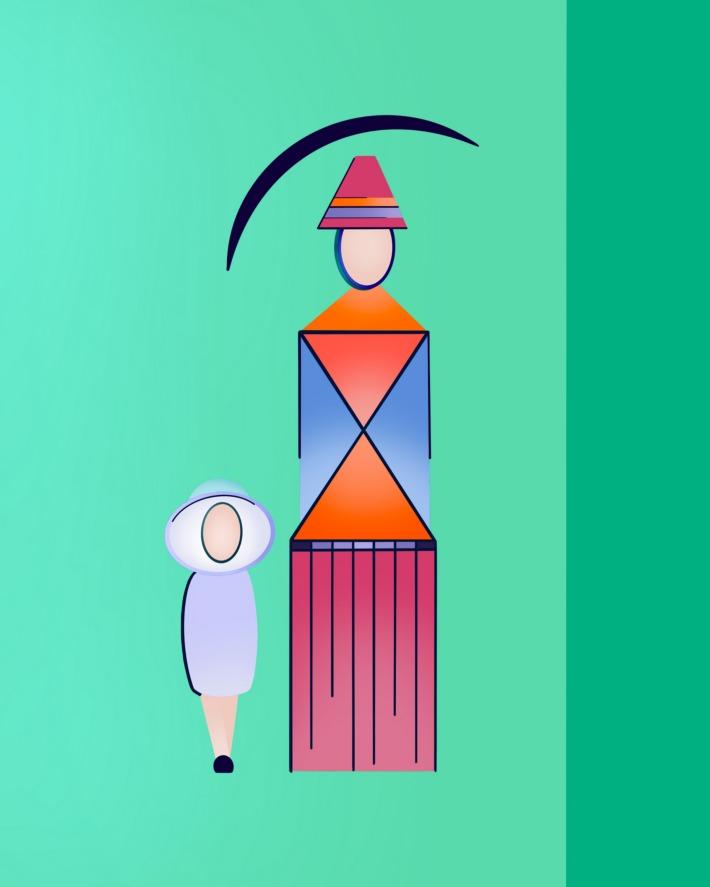

Relaxing in the Park Study
Combining my initial traditional painting process and bridging it with technology I capture my favourite colours and their vibrance while exploring multiple creation processes.
Traditional concepts + digital evolution are bringing me deep inspirations for future projects. Currently I am working on bringing my art to life through augmented reality

Dream Variation
animation and interaction. By combining these three techniques, traditional painting, digital painting and digital effects, the results are fabulous. All three worlds of imagination

come together and come to life.
With its unique multilayered visual quality, Sunday In The Park highlights contours of
Pegasus Variation
known reality in an unknown world and seem to invite the viewers to look inside of what appear to be seen, rather than its surface, providing the spectatorship with freedom to
realize their own perception: how important is for you to trigger the viewers' imagination in order to address them to elaborate personal interpretations? In particular, how open

Ballerinas Variation Variation
would you like your works to be understood?
Dominique Czerednikow: Viewers who are sensitive will experience intense inner
emotions. These are the vibrations that generate profound feeling, imagination or discovery that emerges from deep within. Interpretations are left free and independent

to each viewer. The most important thing to me is sharing that feeling like your heart is about to skip a beat. For example, Mademoiselle Variation expresses the depths
of life. Inspired by Renoir’s portrait of Mademoiselle Marie Therese Durand-Ruel I recreated the strong energies of a young girl who’s life and experiences are unfolding and

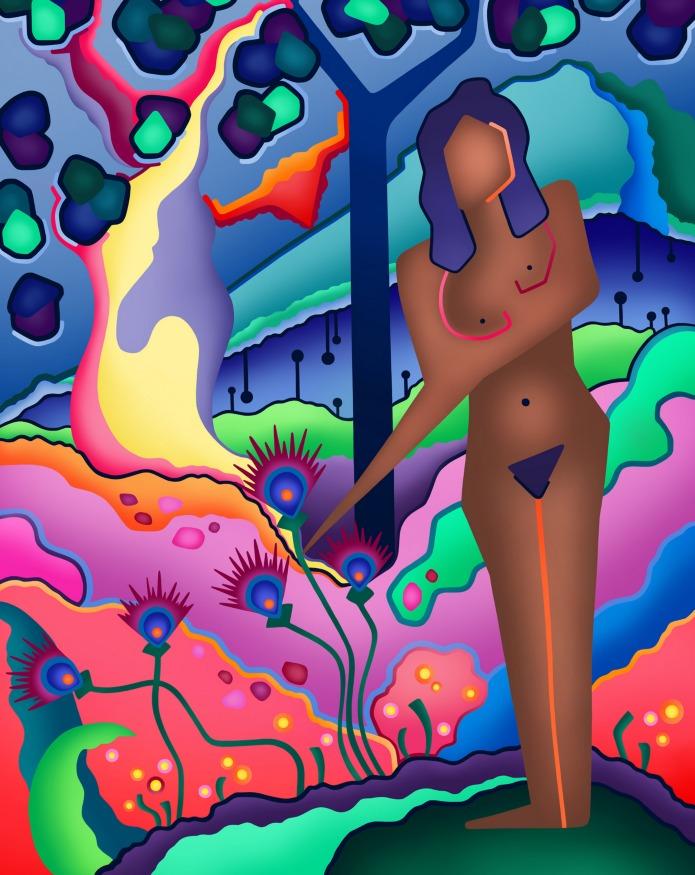
flowing with energy. Her world is deep, bold and infinite. Abstract forms, shading and bright colours create sensations on all their own. How does it make you feel? What do you see?
Over the last year your artworks have been showcased in international digital collections in Miami, Paris and Dubai: how do you consider the nature of your relationship with your audience? Direct relationship with the viewers in a physical context is definitely the most important one, in order to snatch the spirit of a work of Art. However, as the move of Art from traditional gallery spaces, to street and especially to the online realm — as Instagram — increases: how would in your opinion change the relationship with a globalised audience?
Dominique Czerednikow: Currently I am showing my works more in the online realm. Experiencing it in pure physical context is always fabulous. However, I believe no matter how my work is shown to viewers they will be able to experience it and connect with it whether physical or digital.
Social media, especially Instagram allows me to connect with viewers on a different level. On Instagram I like to expose my process. Curious art lovers can check out my works in progress, colour pallets, inspirations and my brush at work. As an art lover myself I am curious and enjoy receiving insight into other creatives’ lives, their processes and inspirations as well as their studio and surroundings. It is out of gratitude and reciprocation that I enjoy sharing mine as well. It is amusing and inspiring. By sharing a little bit extra we, humans beings, have an opportunity to connect with art lovers and creatives’ from around the world!
We have really appreciated the originality of your artistic production and before leaving this stimulating conversation we would like to
thank you for chatting with us and for sharing your thoughts, Dominique. What projects are you currently working on, and what are some of the ideas that you hope to explore in the future?
Dominique Czerednikow: I have a lot in store for the future. Now it is time for me to share my vibrations with the world. In addition to getting my art out into the world I am currently working on three complimentary projects.
Art + Technology. Which brings art to life with augmented reality animations and limited edition art prints.
Art + Fashion. A fashion accessory collection that combines art, design, and Italian excellence. I have brought my colours to your personal style through scarves, foulards and pareos made in Como, Italy using the highest quality silks and digital printing.
Art + Life. A whole new dimension of my imagination is surfacing. New inspirations are coming on strong and stirring a new energy from deep inside me. Following my dreams and breaking free of limitations I am concentrating on my inner voice and beginning a new series of creations. Dive deep into the sea or just sit back and appreciate the waves and reflections. Look out for more fabulous colours and beautiful shapes. My unique world inspired by the sea is going to be authentic, fresh, and most importantly enchanted!
Thank you ART Habens for this fantastic experience! There is nothing better then digging deep into my soul to answer your questions with words and not paint!
An interview by , curator and curator
Xiuwenbo Wang is a Sydney-based visual artist who through an exploration of illustration in various media—painting, printmaking and photography—probes ideas of humanity, politics, identity, culture, and social issues. Xiuwenbo is also a published author who frequently collaborates with other artists, social activists, and philosophers, often going so far as to have creative ideas written as the impetus to his intricate artworks.
Is There Any Hope
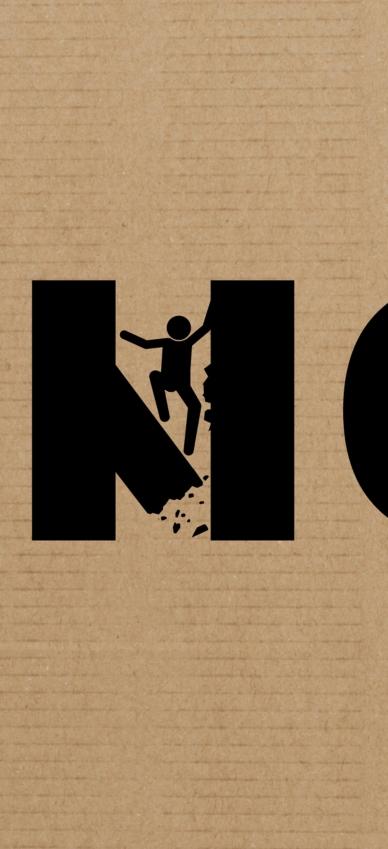
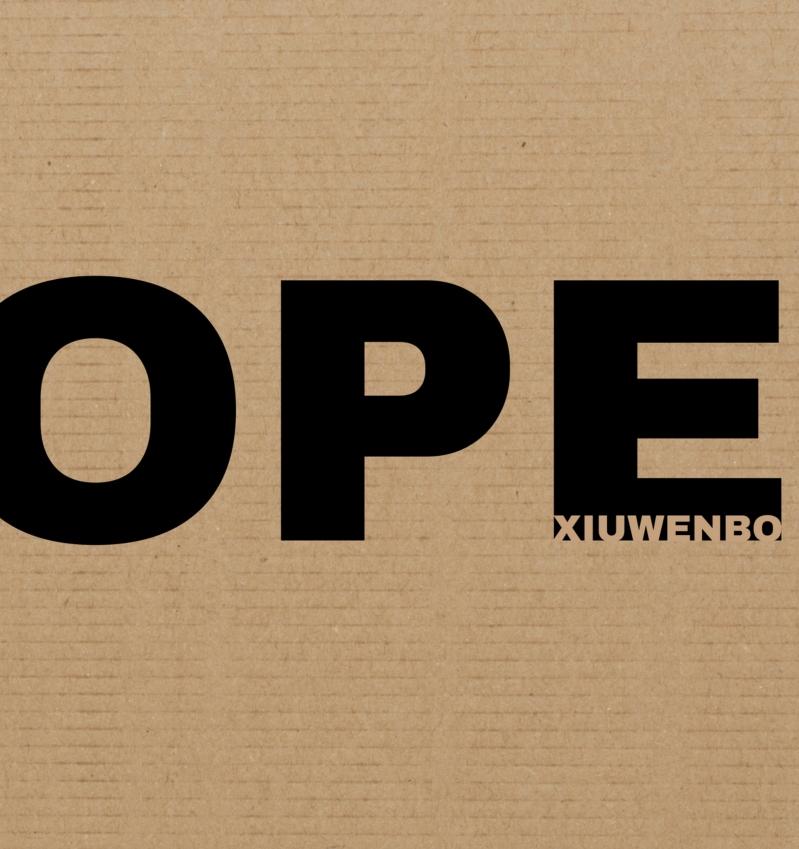

Xiuwenbo Wang
 An interview by , curator and curator
An interview by , curator and curator
Hello Xiuwenbo and welcome to ART Habens. Before starting to elaborate about your artistic production we would like to invite our readers to visit https://xiuwenbowang.wixsite.com/home and we would start this interview with a couple of questions about your background. You have a solid formal training and after having earned your Bachelor of Arts from the University of Jinan, you moved from China to Australia, to pursue your Master of Arts and Commerce, that you received from the Univesrity of Sydney: how did those formative years and your cultural substratum influence your evolution as an artist? Moreover, are there any experiences that did particularly help you to develop your attitude to experiment?
Xiuwenbo Wang: Hi. First of all, thank you very much for the opportunity to speak with you and all dear readers of ART Habens about my artworks.
Some people said that art is a window through which everyone can have his/her the most personal view and the most personal is the most creative. For that, I couldn’t agree more. What I’ve been longing for from art is to build my own window, from which I could see my personal view, a reflection of my world. I was born in Jinan, Shandong, in northern China. I grew up there and spent a lot of my youth exploring a broad arts education by travelling around, reading and observing the fullest details of the city I live in. After I received my bachelor’s degree in Arts, I made up my mind to leave for Sydney to continue my art exploration and at the same time, I study Business Analytics. The analytical skill I acquired gives me the ability to have a
meticulous examination of subjects in my works from as many perspectives as possible, bringing me more insightful and inspirational ideas.
I’m a believer that we all share a collective imagination, which will connect and tolerant conflicting ideas and concepts. Artworks are the reflection of the artists’ own world. Imagination is a notion consisting of historical, geographical, familiar factors. These factors are combined together and we call it culture. Growing as an open-minded person, I’m lucky to go to see the world, embracing diversified culture to lay the foundation of my artistic production that is in
Xiuwenbo Wangattempts to establish connections and resonation.
For this special edition of ART Habens we have selected your OUT OF FOCUS series, a stimulating project that our readers have already started to get to know in the introductory pages of this article. What has at once captured our attention of your exploration the outmoded expectations about humanity is the way its visual language is used in such strategic way to counter-balance subjectivity and offers an array of meanings. When walking our readers through your usual setup and process, would you tell us how did you develop inital ideas for your OUT OF FOCUS series? In particular, do you create your works gesturally, instinctively? Or do you methodically transpose geometric schemes?
Xiuwenbo Wang: Being insightful and creative doesn't have to dig deeper through the surface of certain subjects. Instead, I try to discover more relevant dimensions that no one had never remarked before. The discovered dimensions can be related directly or indirectly to the core of the idea I wanted to convey through visual elements. Most of the process of my artistic production is instinctive. I don’t methodically transpose geometric schemes. OUT OF FOCUS is the project I’ve been working on for a long time. The initial idea came from an experience when I took a group photo in my exhibition. I was rushed, clicking the shutter button without focusing on people. So, I got a very blurry picture. I personally love this blurry picture I took, but people whoever looked at it said the picture is useless.
I reckoned the picture was indeed out of focus but I saw another sense of beauty. The blurry picture shows me another perspective of observation. People in that picture are edgeless while light has a shape like a concrete object.
Thereafter, OUT OF FOCUS became one of my special ways of seeing things around me. As a project named OUT OF FOCUS, I featured a lot of artworks engaging with global issues discourses. I addressed those topical issues by manifesting complexity and urgency in their simplest way. Meanwhile, I highlight my subjective observation of some hidden perspectives to establish a sense of relevance and contradictory. Everything in my work will be like that out-of-focus picture.
With their unique visual identity, your artworks challenges the viewers' perceptual parameters: we daresay that your artistic practice seems to aim to look inside of what appear to be seen, rather than its surface, providing the spectatorship with freedom to realize their own perception: how important is for you to trigger the viewers' imagination in order to address them to elaborate personal interpretations? In particular, how open would you like your works to be understood?
Xiuwenbo Wang: It seems that people nowadays have lost their courage to imagine because reality has been way beyond our wildest imagination. The global community has been faced with the challenges brought by a series of factors, such as disruptive technology, subversive theories, military conflicts, negativity on the internet and so on. The more we are exposed to the outside world, the more vulnerable our imagination becomes. The bright side is that people are eager to seek the way out.
I regard imagination as the greatest ability that is able to set people’s mind free. Perceptual freedom is in short supply these days. It requires independent thinking. I don’t wish to tell people what is right or wrong but only provide perspectives we mostly ignored to encourage the audience to discover more for
themselves. If the audience found something interesting to inspire them to imagine, letting go of shackles of stereotype and prejudice, I’d feel happy for them even though they might draw a completely different conclusion.
Mexican artist Gabriel Orozco once stated, "artists's role differs depending on which part of the world they’re in": as an artist particularly interested in exploring global issues and challenging controversial and

societal taboos, do you think that your artistic research respond to a particular cultural moment? In particular, do you think that artists can raise awareness to an evergrowing audience on topical issues that affect our

globalised and everchanging society?
Xiuwenbo Wang: People are products of their own environment. Artists are no different. There are 7 billion people in this world, so
Terms and Conditions

there are 7 billion stories to tell. Each and every one of the stories can resonate with the rest of the world. I consider artists are a group of people who care about people by telling good stories.
If artwork is a person, I’d say that stories are bones and art is flesh. I’ve had plenty of experience of looking directly at a piece of artwork and at the same time, feeling like looking a person or people in the eye. That was the best
experience ever happened to both artists and the audience like me. Individuals and the stories behind the work will be strongly connected because of that. Without a sense of stories, particular perceptual challenges can
never be powerful and unforgettable. Off course, my works are in attempts to concentrate on some certain topical issues and social taboos like consumerism and social indifference, but normally I don’t think too
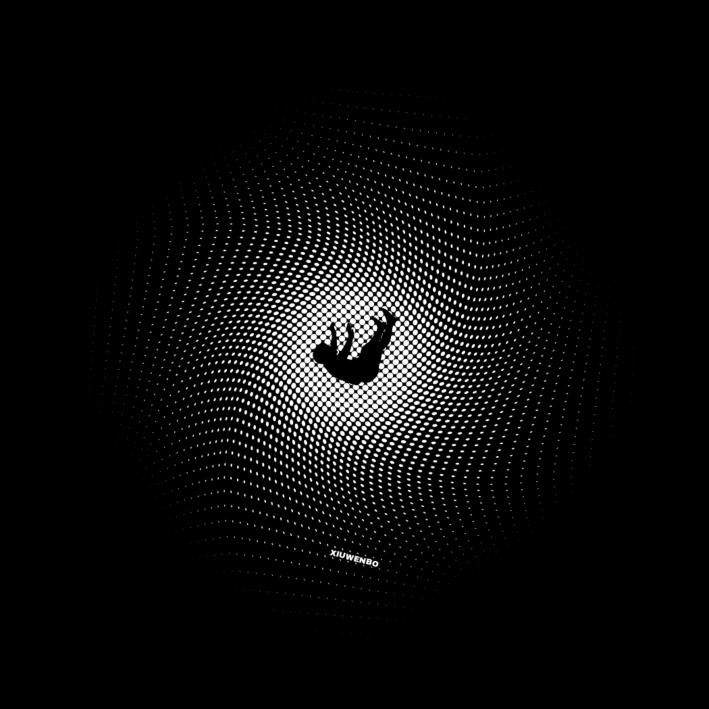
much when I am in the progress of artistic production. Globalised society is a creation under the mixed effects of the progression of the civilisation. And I understand there is no such thing as to be flawless. To me, I try my
best not to overreact especially before careful observation and examination of its origin. If I have to put some personal discoveries into my work, dark humour would be my favourite way of expression. I never have a single

thought that I could outsmart the majority of people and I put my faith in them. I don’t need to draw a crowd to sale whatever I represent and let everyone have to listen to me. Normally global issues and controversial and
societal taboos don’t have a single aspect. What I do is to provide more perspectives in a funny and amusing way. Solutions are limited, but creativity is limitless. I know what I do and I will keep doing that in my own way.

Another interesting series of yours that has particularly impressed us and that we would like to introduce to our readers is entitled ONE DAY LONGER and we have appreciated the way it embody an interface between realism and
imagination. Scottish painter Peter Doig once remarked that even the most realistic paintings are derived more from within the head than from what's out there in front of us: how do you consider the relationship between reality and

imagination playing within your work? And how does everyday life's experience fuel your artistic research?

Xiuwenbo Wang: Humans seem smart enough
to distinguish reality and dreams, but it will not be true unless they are truly awake. We are living in the era of daydreaming, and most of us have no intention to wake themselves up. Global leaders are promising a huge pie for
Interfaces

the public. Economists are blowing their horns for the booming of the economy.
Celebrities are overusing social network to keep showing people their worldly famous
and influential selfies. Everything looks just fine as it should be. What a real fantasy. Thanks to the internet, we are transforming from lacking information to an information explosion. The consequence of information
explosion is that our heads are full of garbage. We seem all-knowing so we indulge ourselves to be arrogant and ignorant. We can barely tell what is genuine. We can't follow our heart any more. We failed to keep up with the standard
set by other people's rules. Luckily, we have imagination, to clarify everything confused by ourselves.
People perceive things based on perspectives and contexts along with the help of

The Beginning of the End

imagination, so how can we be confident to say that our reality is truly reflecting our true self? After all, everything is out of focus in one way or another.What I’ve been trying to accomplish through my series projects is to
unveil the interface lied in between reality and imagination. But my discovery tells me that reality has its own imagination. That impression keeps me vigilant and inspired.


The Border

We have really appreciated the vibrancy of thoughtful nuances that mark out some of the works from your ONE DAY LONGER series, and we like the way they create tension and
sense of dynamism: how did you come about settling on your color palette? And how does your own psychological make-up determine the nuances of tones that you decide to
The Self-taught human
include in your artworks?
Xiuwenbo Wang: Picking colours is the most time-consuming part of my artistic production.
I’m no expert, but I do understand what colour can perfectly reflect the topic in my work. In my spare life, I like to study colour palette of scenes in the movies. Colour can
The Heartbroken One

reflect the character’s inner world and affects the audience psychologically, without us being aware. Picking the right colour can be the strongest device in a story.
When I practised drafting, I first put myself into the imaginary story to feel the scene like a movie director and to see what else do I miss. And then I would adjust accordingly
Slide to Power Off
afterwards. I was obsessed with doing that. It was efficient and fun.
Sometimes the colours I picked was designed to make the audience comfortable. Sometimes
I just want to spice things up, increasing the level of tension like the silence before the storm.
Sometimes I will make every element in my work pale to express disappointment and a sense of

The Self-taught human
powerlessness which might resonate with the younger generation.

Anyway, colour is more than a tool to let
everything I create look great. Colour is the mirror that reflects people’s psychological side.
We have particularly appreciated the way you
adapt printmaking with traditional fine art and mixed media, to reinvent and challenge the idea of tradition. How do you consider the relationship tradition and contemporariness?
Xiuwenbo Wang: Art has no rules. Rules come with the order, predictable behaviours and unsurprising outcomes. We live by the rules. Why we go to the gallery to see something that has no rules. Why art can never stop overwhelming us. The thrill and excitement when we look at artworks are reflecting the exact chaotic mixture of our emotions we’ve been longing in our inner mind. I appreciate the genius who invent techniques in art history so that artists nowadays can stand on giants’ shoulders to deepen and strengthen their own expression of longing for the chaos.
I love contradicted but relevant factors. I love to illustrate them in my own works. I adapt printmaking and many other media of art. I understand that reinventing shouldn’t be an equation of one form of art plus another. Getting out of the box of rules is the key. Being against rules doesn’t only belong to contemporaries. In the grand scheme of things, every type of art is the pioneer in its own time, no matter what techniques they used, no matter what methods they applied. In history, every type of art is challenging its own idea of tradition. There is one characteristic that applies to all types of art: innovative.
In essence, tradition and contemporariness are the same things. In the artists’ mind, there is an ever-changing vision. Even the most innovative ideas at this moment will turn to be the tradition and meet its designated challenger one day in the future like a loop of human history. People will perish but art will stay young.
Your artworks, as the interesting The Pigeon of Liberty and The Heartbroken One, feature images rich of symbolic value: how would you
consider the role of symbols playing within your artistic production?
Xiuwenbo Wang: Since I was very young, I’m a fan of simplifying everything I do to let myself get more rest. A lazy boy with a mind-set of streamlining is the best. I am still that boy. With the development of technology, the electronic devices we use nowadays are becoming smarter. Some have outsmarted us. Those devices are very good helpers to simplify and streamline our daily life and make it easier and better. For us to use conveniently, the interfaces of those devices have applied symbols and icons to guide us to operate the tool easily and correctly. I once felt humiliated when I can only get the idea by reading some simplest symbols. But afterwards, I turned to think about it again and decide to study how they really affect our perceptions of life.
I love featuring the elements which are full of symbolic value. My series projects mainly concentrate on people, but creating images of people in the way they should be will fail everything I wanted to add upon. Therefore, mostly I employ images like a pigeon, a balloon dog as symbols to describe the people whom we’ve been overlooking for a long time, establishing a sense of relevance and leading it into an open discussion in my work. Using symbols was poetic and less time-consuming, so I can have more time to take a nap sometimes.
Over the years your artworks have been exhibited in many occasions, including your recent participation to Lloyd Rees Memorial Youth Art Award, at the Lane Cove Gallery, in Sydney: how do you consider the participatory nature of your relationship with your audience?
Direct relationship with the audience in a physical is definetely the most important one, in order to snatch the spirit of a work of Art. However, as the move of Art from traditional
gallery spaces, to street and especially to the online realm increases: how would in your opinion change the relationship with a globalised audience?
Xiuwenbo Wang: It was such a privilege to have experiences of exhibiting some of my artworks in galleries for months. My exhibitions gave me something more than just confidence. It was a sense of participation, allowing me to participate in a kind of conversation between me and the audience. I love watching buyers and visitors stand in front of my work and have a long or short discussion with people around them. Sometimes I’m quite surprised when I overheard their unexpected perceptions, which provides me with another direction to explore and some interesting and insightful ideas. Before exhibiting my artworks in galleries, I've made street art and mural around authorised places for a period of time. That was once my most ideal place to create. I admire street artists’ attitude and their courage to playing a role as a proactive social activist, which deeply inspire me in many ways. One day there was a post I accidentally found on Instagram, a picture of me spray-painting a graffiti taken by a visitor in the graffiti tunnel. Then I realise it would be a good idea to open an account to post my past works. Categorise my posts by hashtags so that there are more people can see what I’ve been doing and leave comments. Thanks to social media, I also become one of the audience by following some emerging artists or wellestablished artists to keep up with their talents across the globe.
There are a lot of options nowadays for artists to choose their favourable or suitable places to showcase their thoughts and ideas. For me, it doesn’t matter if it is a street wall, a gallery or social media. There is one thing I understand
that no matter where you are, there is always an audience who appreciate your works.
We have really appreciated the originality of your artistic production and before leaving this stimulating conversation we would like to thank you for chatting with us and for sharing your thoughts, Xiuwenbo. What projects are you currently working on, and what are some of the ideas that you hope to explore in the future?
Xiuwenbo Wang: Thank you so much for the interesting questions that made me rediscover everything I’ve been doing, ideas and thoughts of my creations.
Currently, I’m working on my new book, a collection of my recent artworks and essays. Besides, I’m also preparing to re-edit my first book of poetry, Leave Town by Tonight. Both of these books will be published later this year. As my first published book, Leave Town by Tonight has been available in Australia, New Zealand, US, UK, Netherlands, Japan and so on. This book’s success not only gave me the confidence to keep writing but also brought me plenty of new ideas which I wish to apply to my future creations and publications. My updated personal website is online. For more information, please visit https://xiuwenbowang.wixsite.com/home.
Finally, I want to say that right now we are facing an unprecedented global health crisis, and my heart is with you. We can get through this Coronavirus pandemic together. Stay home. Stay healthy.



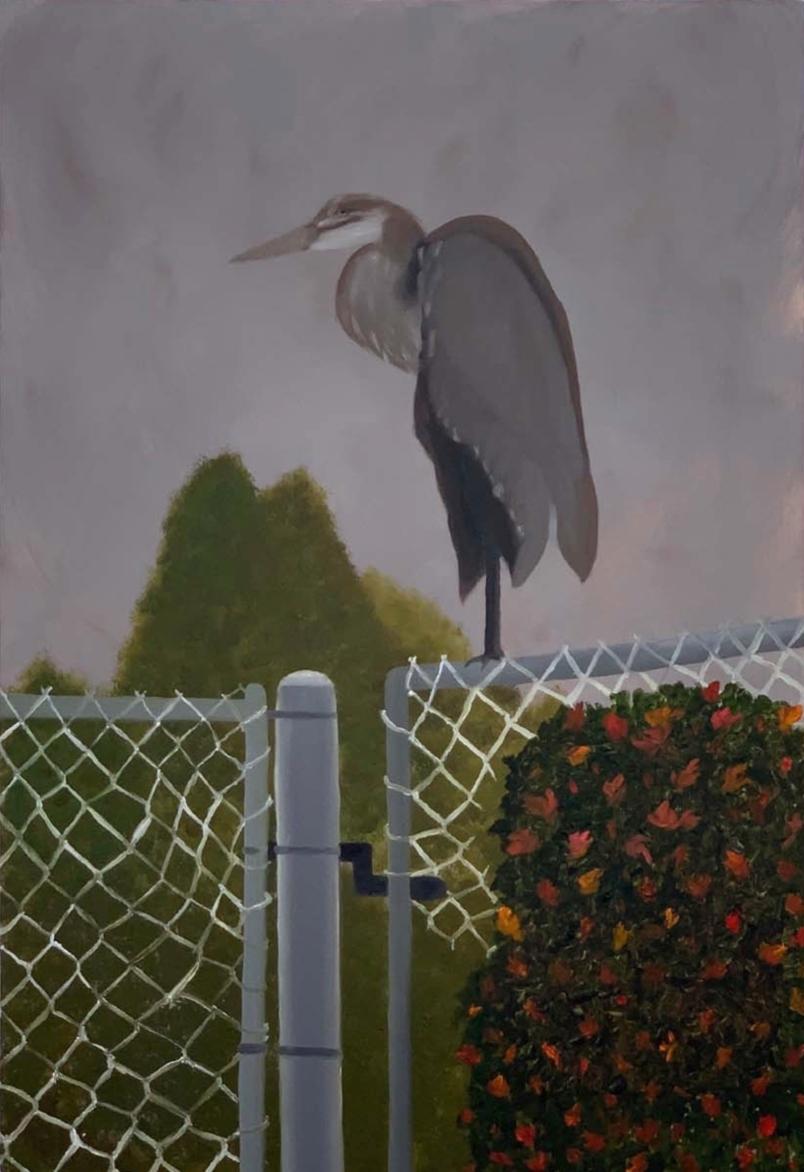
Deitra Charles
 An interview by , curator and curator
An interview by , curator and curator
Hello Deitra and welcome to ART Habens. Before starting to elaborate about your artistic production we would like to invite our readers to visit https://www.deitracharles.com and we would start this interview with a couple of questions about your background. You hold a Bachelor of Arts degree in Individualized Studies from Loyola Marymount University, in Los Angeles, and after a 20-year stint in the automotive industry, you decided to returned to school, to nurture your education with a Master of Fine Arts degree, that you received from Claremont Graduate University, in California: how did those formative years influence your evolution as a visual artist? Moreover, how does your cultural substratum direct your current artistic research?
Deitra Charles: Thank you for this wonderful opportunity. Studying visual art and costume design as an undergraduate student was enjoyable and rewarding; yet, upon graduation, I was not prepared to pursue a career as an artist. Unaware of how to begin to market my work or create a brand for myself, I sought the security of a corporate job in the automotive industry. My education did however lay a foundation that I would later revisit. Although my jobs were not creative in nature, I frequently attended art classes as a means for my creative outlet. Ultimately, pursuing my Master of Fine Arts degree made me realize that there was such a great hunger
and appreciation for the arts that was missed in my younger years.
My cultural substratum drives me to seek answers through ancestry research. Much of what is known about my family history has been passed down through stories. This creates a great sense of responsibility to research and memorialize my
Deitra Charlesfindings. Such research extends beyond my ancestors and carries over to the unsung people of the African diaspora who framed the nations in which they lived.
Marked out with such unique visual identity, the body of works that we have selected for this special edition of ART Habens —and that our readers have already started to get to know in the introductory pages of this article —has at once captured our attention for the way you use your visual language in a strategic way to explore ordinary life, creating such emotional and thought provoking bridge with the viewers. When walking our readers through your usual setup and process, would you tell us how do you usually develop your initial idea for your portraits? Do you create your works gesturally, instinctively? Or do you methodically transpose geometric schemes?
Deitra Charles: A fair amount of time conducting research is spent before starting a project. Often, it is something that I have been wanting to create for many years and I suddenly feel that the time is right. The approach taken when starting a painting is to look at the canvas and question what I would like to have painted on it. Other times, I look at a photo as source material and map out in my mind how I would like to edit it. Using my mind as the viewfinder, I mentally place the image onto the canvas and start. Often I start with a plan but it almost immediately morphs into something quite different, such as with Trespassing - Loitering forbidden by law. The original concept was to have a sign with this verbiage, however, I decided that lettering would not be appropriate in this painting so I edited it
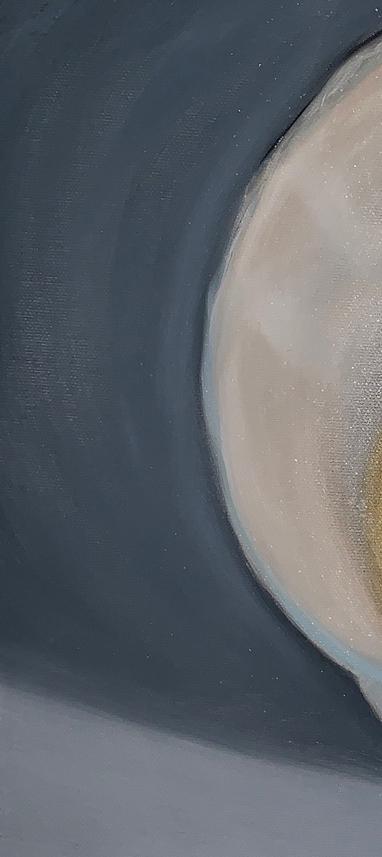
A cup of tranquility

Navigating Life - He side eyed me

out and used the language for the title instead. Using primarily oil on canvas, I have greater control over the rhythm in my paintings. Painting with graphite is another joy because it gives a historic nuance. Gestural movements are preferred allowing an uninhibited free spirit.

We have really appreciated the vibrancy thoughtful nuances of tones that mark out your artworks, and we like the way they create such sense of peace and release, as in A Cup of Tranquility and Inner Peace: how did you come about settling on your color palette? And how does your own psychological make-up determine the nuances of tones that you decide to include in your textures?
Deitra Charles: A peaceful and calm person by nature, I connect with images and colors that speak to serenity. When selecting a color palette, I often mix colors close to what I see in my source material, however, in the past few years, I have found that Payne’s gray is a color that I like to mix with other colors that I have already blended. It seems to bring everything down from a yell to a whisper. This is important to me because my ideal takeaway for viewers is to leave with a sense of peace and relaxation.
You were born in 1968, a year that changed the world and that shaped a generation in its entirety and the ones that succeeded. As you have remarked in your artist's statement, while you would not comprehend what was happening until you were of school age, the events of that time inspire you to create calming and unifying works of art how do your memories inspire you and how does everyday life's experience fuel your artistic


Deitra Charles: Experiencing moments of joy seeing a black person on television and getting excited when there was actually a show starring black people should not have been the norm, but it was when I was a child. Unfortunately, depiction of black culture was almost always demeaning. Turning to homelife for real experiences and truth is what gave me a sense of pride about my race and culture. My mother raised me and my siblings to love, respect, and appreciate all people and cultures.
Black history was not taught in the predominantly white schools that I attended, so much of what I learned about my ancestors came from home. My older siblings taught me about people in history such as Madam CJ Walker who I felt compelled to include in my first year group show in graduate school. It was a way of introducing her to many who did not know about the first African American self-made millionaire. Feeling vindicated as viewers asked me about this amazing woman, I realized that my memories of learning from my mother and siblings still play a part in what I do and how I convey my messages. Delivering my experiences without force-feeding a position or stance while educating and sharing with a quiet, still voice is my method for communication. It is both learned and innate.
As my mother’s primary caregiver, I am often painting at home. Many of my smaller works were painted on an easel set up at the foot of her bed. This allowed me to spend valued, quality time with her and create at the same time. We discuss family history and the ancestry
that informs our current society while I paint. The stories she tells in the present reignite the past, and guide my artistic research.

Some of your artworks draw from the specific of natural environment, as Hope: concurrently, and in an independent way, you
also capture beauty in urban details, as you did in the interesting Untitled (Bird) and The watcher, and we have highly appreciated the
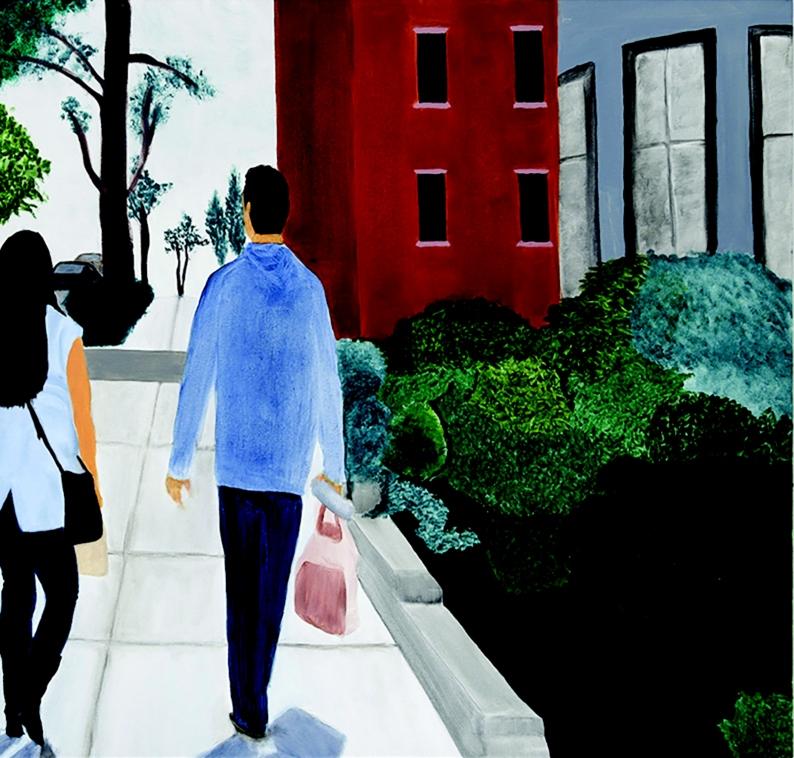


Goodnight sweet Lorraine

way your works highlight such insightful resonance with the places that you portrait: how do you select the specific locations and how do they inspire your creative process?
Deitra Charles: Understanding the significance of our daily surroundings is paramount. We need to embrace what is before us and not go through life with blinders on. It is because of my deep respect for nature that I am in tune with the beauty of seemingly simple landscapes and common wildlife especially that seen in urban areas. A photograph, taken by a dear friend, of a sunset and tranquil lake was
my inspiration for Hope. It is a scene often viewed but I want observers of my painting to absorb every moment. Capturing just a snapshot of life and allowing viewers to hold on to it is my goal.

My paintings depicting wildlife in urban environments is another way that I show the everyday in life and appreciation for nature. Some of the intersections between the urban and the wild that are portrayed in my work were sourced from scenes captured in my own backyard. Both Untitled (Bird) and The watcher were painted from photos that I took of a finch
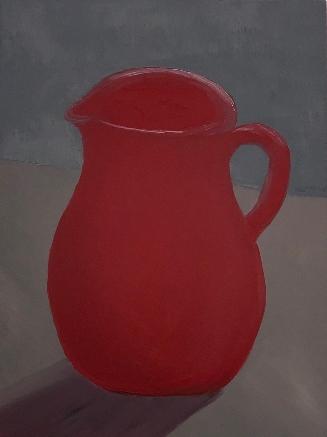


and pigeon respectively as I spent time outdoors. They represent the structures in urban society and how animals navigate around and with them.
You also created a number of portraits, and we have appreciated the way you sapiently provided My brother and Cecelia Reed — and especially Three windows, an amazingly great work that has suggested the idea of sincere love behind different generations — with such powerful narrative drive: what’s your philosophy on the nature of portraiture? How do you select the people that you decide to include in your artworks?
Deitra Charles: Portraiture uncovers many emotions and facets of the human psyche. It is what I turn to when I want to emphasize depth of character. The raw sincerity of the subject is fully exposed and draws the viewer in for an intimate conversation. Some images resonate with me so much so that I know they will become works of art. Editing out unnecessary details, cropping, and adjusting source photos, I close in on what I want the viewer to absorb.
Family members, loved ones, and black women in history have been subjects in my paintings and drawings. Having such a close relationship with my family, I find it easy to use them as subjects in my work. The warmth and love transposes onto the canvas as I paint. It seemed natural for me to use those close to me as the sources of my artwork yet it has come into question during studio visits. Finding validation in David Hockney’s work, I am particularly inspired by 82 Portraits and 1 Still-life where Hockney painted portraits of friends and acquaintances in poses depicting their character.
Three windows was created from a photo that I captured of my mother, brother, and nephew. They appeared to have such a wonderful time

and just as the viewer looking at the painting, I too do not know the nature of their conversation, but I insert my own ideas based
upon their expressions and body language. My brother is a painting of just that - my brother. Using a photo of him from the 70s or 80s, I
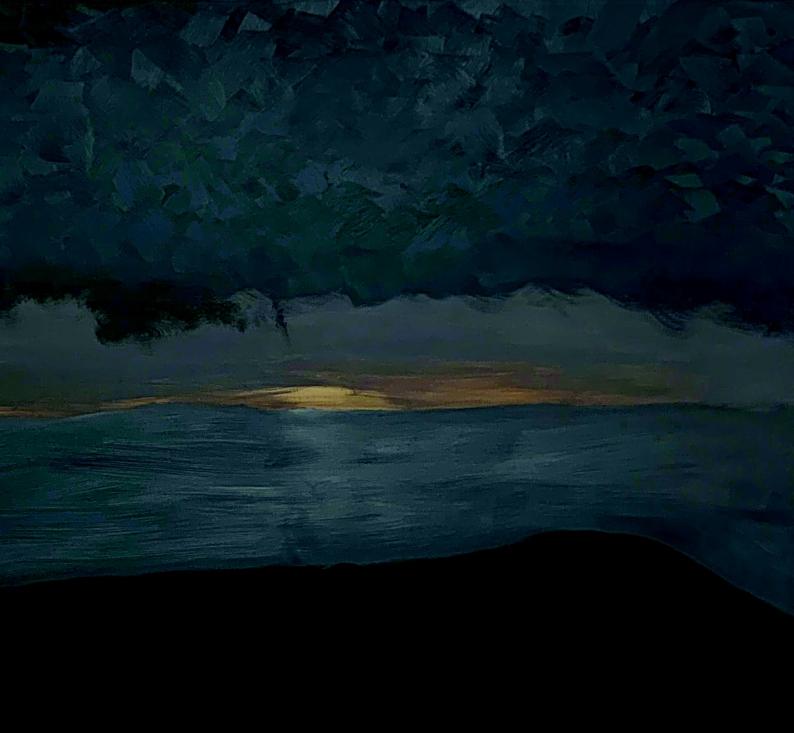
Untitled
wanted to represent black pride while, at the same time, making the painting approachable. It is often something that members of society
do not think possible; to exude pride in oneself as an African American and also be amicable. My graphite painting Cecelia Reed is from a rare

photograph of my great grandmother. When I started researching unsung black women in history, I realized that I only had to look as far
as my own ancestors. Painting my great grandmother’s portrait and naming the piece after her implies a certain importance and begs the question “Who is she?”.
Mexican artist Gabriel Orozco once remarked that "the artist’s role differs depending on which part of the world you’re in. It depends on the political system you’re living under": do you think that your artistic research respond to a particular cultural moment? Moreover, as an artist fully committed to promoting for collective, societal peace, what could be in your opinion the role of artists in order to raise attention to topical issues in our ever changing contemporary society?
Deitra Charles: Artists have an enormous responsibility to ensure that what we put out is impactful, insightful, and elevating. Some works might be controversial but they should not be such just for the sake of being controversial. Art should draw attention to an issue or idea and generate intelligent conversation and positive action. Although I create work that is calming and inviting, it often evokes underlying questions of acceptance and diversity. My art in particular is an inevitable response to many historical moments, building upon themselves in succession. My hope is that viewers engage in respectful communication surrounding my work and leave in a better place emotionally.
Although primarily representational, your drawing and painting convey such unique combination between reality and the realm of imagination, creating such powerful bridge the past with the present. Scottish painter


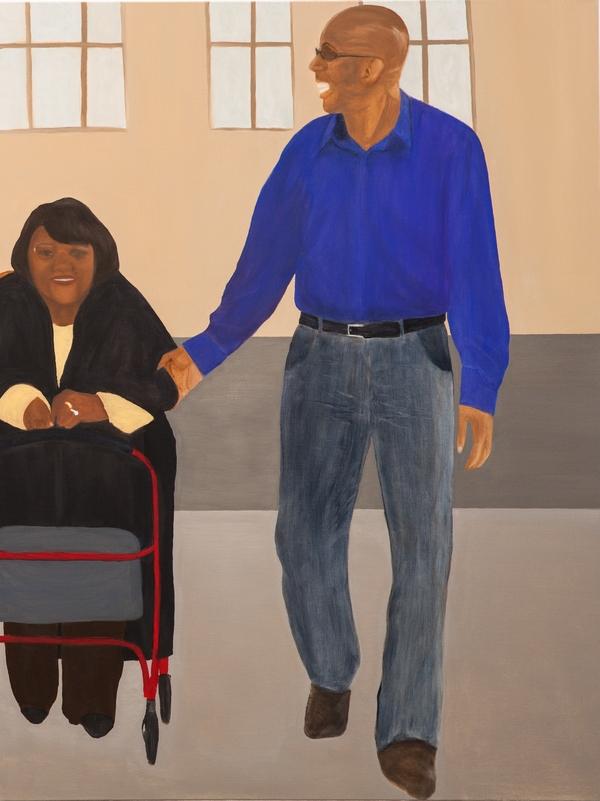
Peter Doig once remarked that even the most realistic paintings are derived more from within the head than from what's out there in front of us: how do you consider the relationship between reality and imagination, playing within your artistic production?
Deitra Charles: Each time I start a painting, realism is played out in the back of my mind. The stigma of creating realistic art is constantly in my head; however as I paint, my hand does just what it wants to do. The more I shake the idea of creating realistic art, the more fluid my work becomes and I give myself permission to


be an artist. Starting from a place of reality strengthens my work as it is a springboard from which I catapult into an imaginary place. My initial concepts do not exactly mirror my finalized pieces. Constant editing takes place even as I am painting, substituting details for the representational just enough to maintain elements of reality but loose enough to divulge what is in my mind’s eye.
You are an established artist and over the years your work has been exhibited in solo and group shows in Los Angeles, Pomona, and Claremont, California: how do you consider

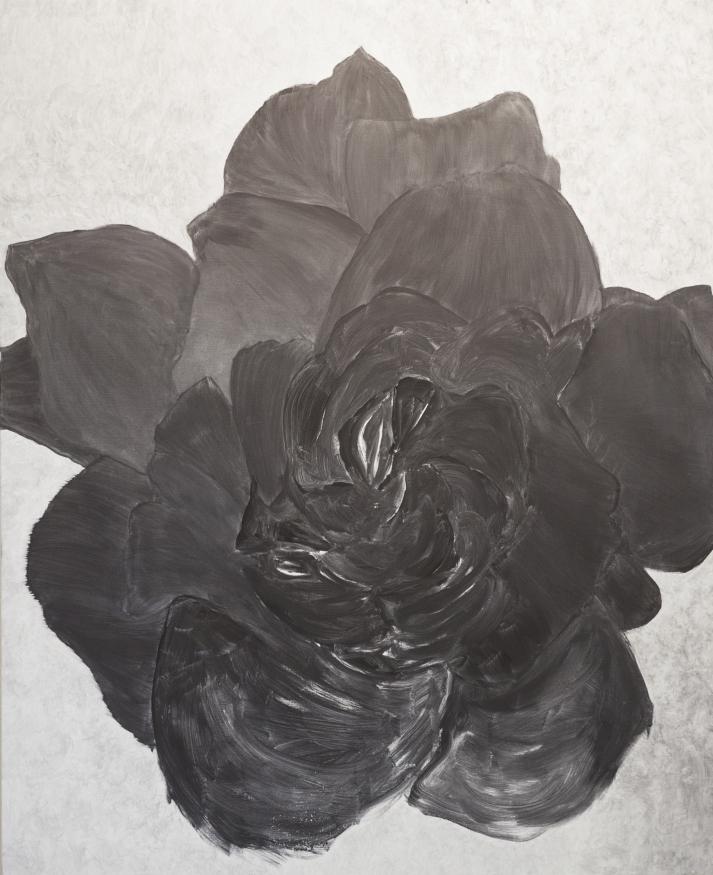
the nature of your relationship with your audience?
Deitra Charles: Viewers tend to gravitate toward one style of my work or another. Some relate to my paintings integrating animals into urban scenes and they share stories of times that they encountered a squirrel or saw a mallard in an odd place. Others connect more with the moods conveyed. My enjoyment comes from hearing how my paintings remind them of an emotion or experience and listening to their interpretation of my work. This is
gratifying because as personal as my paintings are, I want them to mean whatever they mean to the viewer. Those who come to see my work are able to relate to some point in time in their own lives, and through this, I am able to connect on a deeper level that transcends paint on a canvas.
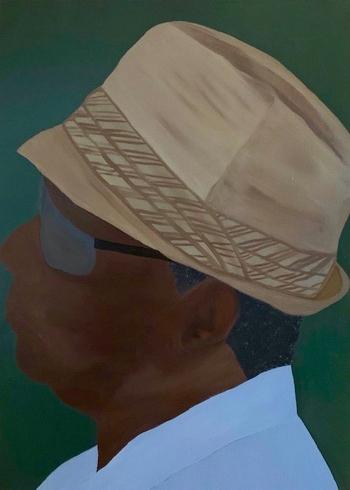
Working from your artist studio in Downtown Los Angeles, you are in the hub of creatives and world-famous galleries: direct relationship with the viewers in a physical context is definitely the most important one, in order to

snatch the spirit of a work of Art. However, as the move of Art from traditional gallery spaces, to street and especially to the online realm — as Instagram— increases: how would in your opinion change the relationship with a globalised audience?
Deitra Charles: Art should be accessible to all. Whether a child from an underprivileged background or a wealthy entrepreneur, they should have access to the same art. Our appreciation of art starts early and must be fostered. While the experience of a gallery showing is rewarding and a bit of an ego boost for the artist, the greatest benefit of having a show is that the works are seen up close. Some art does not photograph well and the in-person viewing enables one to see the work that went into a piece. There is also the privilege of communication between the artist and guests where the artist shares first-hand information about the process. Yet, as more and more galleries move to online shows, art is becoming more accessible to those who, for whatever reason, can not visit galleries. ARTHabens is a platform where people like me can see the work of other artists from around the world. I might never see a show by some of the artists showcased in your online publication, but it provides a different type of viewing experience with a broader reach. As such, I invite your readers to access some of my work online at https://www.deitracharles.com and via Instagram @deitrac.
We have really appreciated the originality of your artistic production and before leaving this stimulating conversation we would like to thank
you for chatting with us and for sharing your thoughts, Deitra. What projects are you currently working on, and what are some of the ideas that you hope to explore in the future?
Deitra Charles: It has truly been a pleasure, however, much has changed in the world since the start of this interview. The World Health Organization has declared COVID-19 a pandemic and countries are closing borders in an effort to slow down the spread. There is much fear and uncertainty circulating which inevitably has an impact on what I create. Just prior to the outbreak, I was nearing completion of a painting similar to Hope because I was already feeling that we need more of this. I had to temporarily abandon this piece because my studio was closed due to a shelter-at-home initiative issued by my state’s governor. Now, as I work on smaller paintings at home, I feel even more compelled to create work that is calming, hopeful, and uplifting. Feeling a greater sense of responsibility, I need to reach those who are afraid, those who are losing faith, those who need to deal with loss, and those who need to know that it will get better. Years from now, analyses of pre and post pandemic art will be telling of the times we are currently in. As an optimist, I am certain that artists will play a great role in mental healing and storytelling and I plan to be a valuable contributor in these areas.
An interview by , curator and curator
Dysfunctional parasol
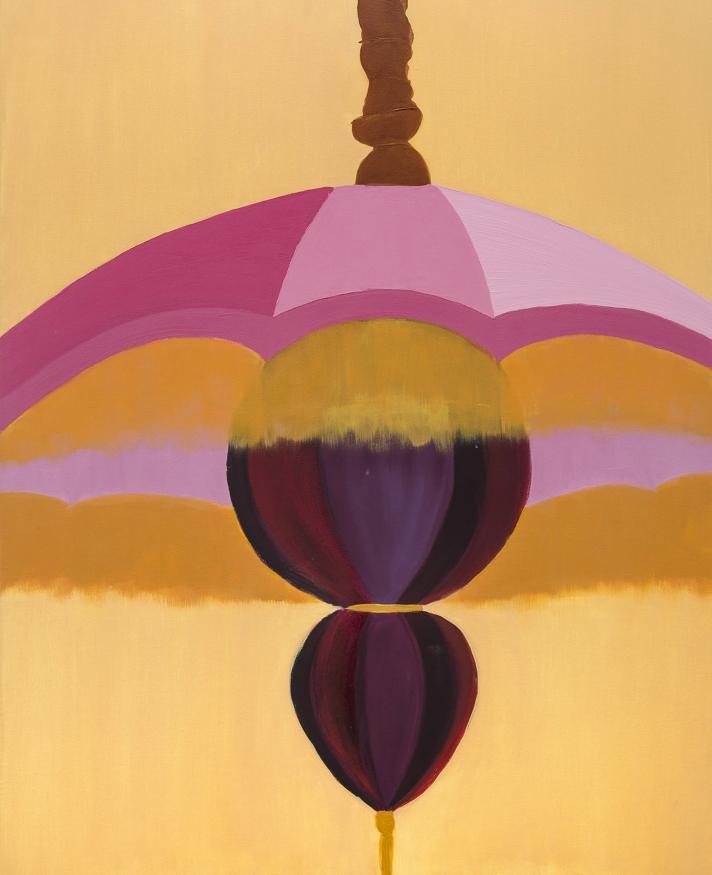
B Went Missing in the Land


Feeling My Way Through the Land
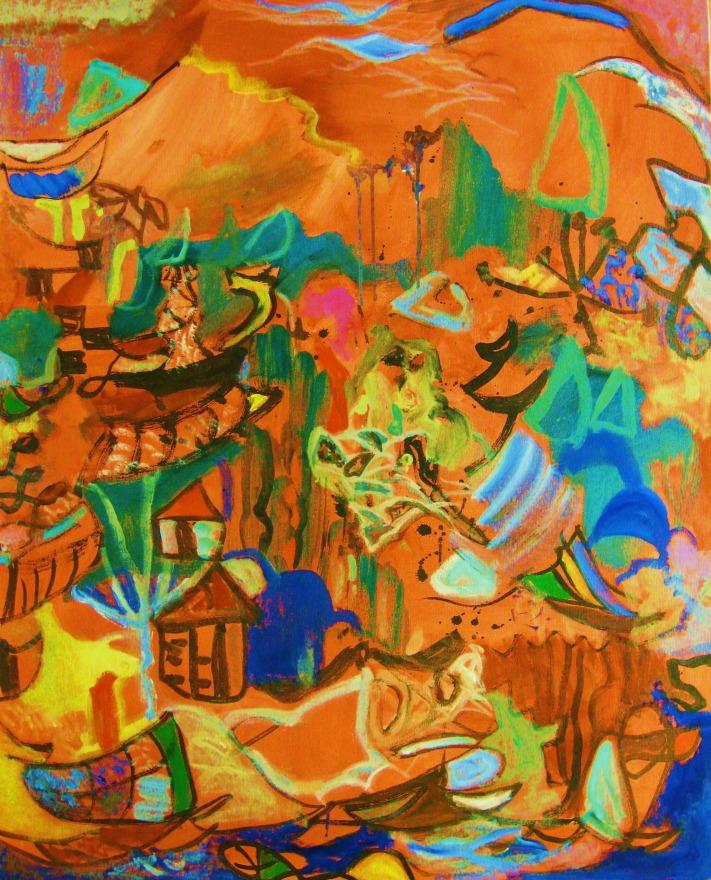
Fiona Stanbury
An interview by , curator and curatorHello Fiona and welcome to ART Habens. Before starting to elaborate about your artistic production we would like to invite our readers to visit https://www.fionastanbury.com and we would start this interview with a couple of questions about your background. You have a solid formal training, and you hold a BA (Hons) in Fine Art, that you received from Canterbury College of Art: how did those formative years as well as your experience at the Mark Rothko painting residency, at Daugavpils, Latvia — influence your evolution as an artist?
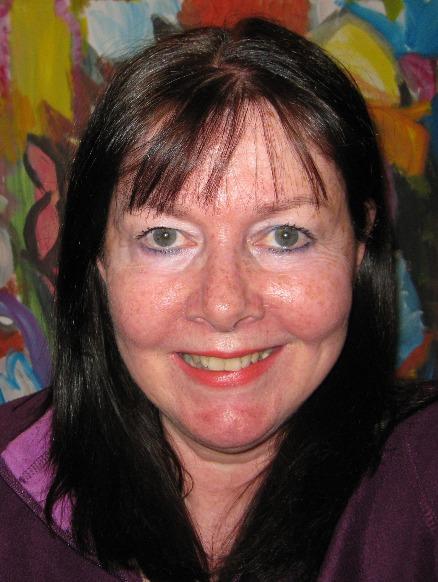
Fiona Stanbury: Before I went to art school I studied for 2 years with a fantastic artist called Valerie Mackenzie who gave me a very thorough training in technique and the use of oil paints. I will never forget my first day of study when I watched her work on a large landscape painting. I watched her for 2 hours and it was my initiation in to the magic of paint. There were no words exchanged and I was incredibly impressed by the way she could convey a tree with one expressive brush stroke loaded with paint. Her work was a combination of traditional English landscape painting and Abstract Expressionism, full of gestural marks of thick colour. She gave me far more training in technique, glazing, and the mixing of colour with mediums than I received at art school, and for that I was very grateful.
At art school I was lucky to have as my personal tutor the renowned Mali Morris who, while an abstract painter, helped me with my semi-abstract explorations of landscape. I was not exclusively drawn to landscape as a realist; at that time my favourite artists were Gillian Ayres, Peter Lanyon, Patrick Heron, Ivon Hitchens, Kandinsky, Stuart Davies, Richard Diebenkorn, among a few to mention, along with Matisse, Picasso, and Grace Hartigan. My 3 years were focused on finding ways to translate the experience of landscape or the figure into an expression that acknowledged my
materials.
The Mark Rothko residency of 2012 was quite a few years after I’d left art school. One of the most influential aspects of being there was the contact with artists from around the world, discussing art with them, and seeing their works evolve during the residency. Also, of course, seeing the original paintings by Rothko that were housed in the building – displaying 3 phases of his work – and seeing artworks by previous residents. The four paintings I made during the residency (which can be seen on my website in the Rothko album) were
Fiona Stanburymostly inspired by trips into the landscape, the particular Latvia green on money notes and houses, and the landing at Riga airport. My largest painting (100 x 140 cm) is called ‘Flying Into Riga Airport’ and was the start of a series about flying over landscape and the most recent of these is Flight To China.
The four paintings I created remain in the permanent collection at the Mark Rothko Centre. I have always loved the freshness of being in new places because it jolts my visual perceptions and ideas of reality and how I put things together on the canvas. This residency forced us to create paintings in 11 days which pushed me beyond my usual ways of working. It gave me more confidence in my emerging visual language which I think is one of the key aspects of being a painter.
Marked out with such unique visual identity, the body of works that we have selected for this special edition of ART Habens —and that our readers have already started to get to know in the introductory pages of this article — has at once captured our attention for the way you use your visual language in a strategic way to counterbalance subjectivity, offering an array of meanings. As you have remarked once, you see your work process as spiraling around different facets in order to widen your connection with materials and ideas: when walking our readers through your usual setup and process, would you tell us how do you usually develop your initial idea for your artworks? Do you create your works gesturally, instinctively? In particular, how do you consider the role of chance and improvisation playing within your work as an artist?
Fiona Stanbury: I allow a cross pollination between my artworks because I always work between several paintings. It allows me to gain a view of what is working and what is not, in a way that would not, for me, be possible if I worked on only one. I can compare the paintings , even if the visual language is slightly different, and see what the weak areas are. I can take an element from one painting in to another, or something may suggest a whole new painting or series. Most



recently I’ve been alternating between collage and painting as a way to explore edges and transitions of colour.
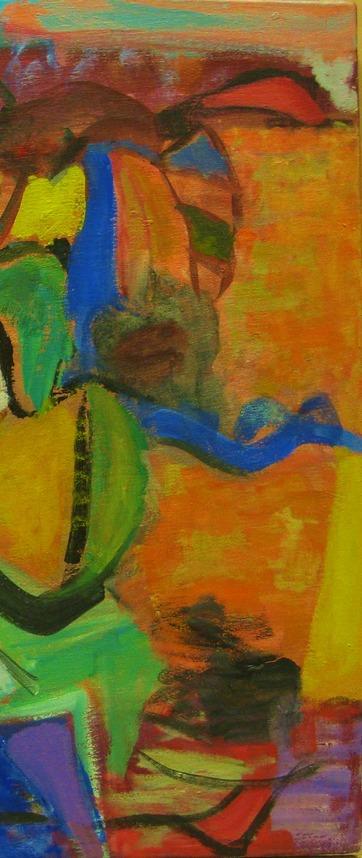
While I could say that landscape has always inspired me, in the last few years I’ve wanted to translate paint into a parallel for the energies and spirit of landscape rather than making a literal copy of a place. My works become a paint poem and in this way I throw out a kind of net to catch possible elements which can then be developed as different threads of thought. There are several ways I throw out this net.
I start instinctively, putting down brush strokes and colour, erasing things, adding elements without censorship in the beginning, until a place or arena develops which I can then delve into. I absolutely consider chance and improvisation as pivotal elements in my process. There’s no planning, I like to ‘surf’ on meanings and follow the personal world that emerges. An example of this would be Flight To China which is about my travelling to China for the 8th Beijing International Art Biennale. I wanted to explore a different kind of language that could convey an idea of not only flight but movement through shapes and marks. I was questioning how landscape can be translated in to paint, what really matters to me, what I can ignore or invent, and how to deal or not deal with horizon lines. This painting began from a series of colours and marks.
Sometimes I start from a title and let the painting evolve from the associations that bounce back and forth between paint and my internal world, sometimes I start purely from putting down paint to see what it might suggest, and sometimes I want to include a narrative around issues such as climate change, as in Three Escape The Deluge. I allow any kind of paint application – I might pour paint, scrape off paint, throw in areas of colour and marks which are then erased. The main thing is to be excited by the image. Working in this unplanned way often takes me back to working as a child when I filled many books with paintings that I began purely from paint and shapes.
Intuition plays a large part in how I work but there also needs to be an intense period of evaluation and reflection.
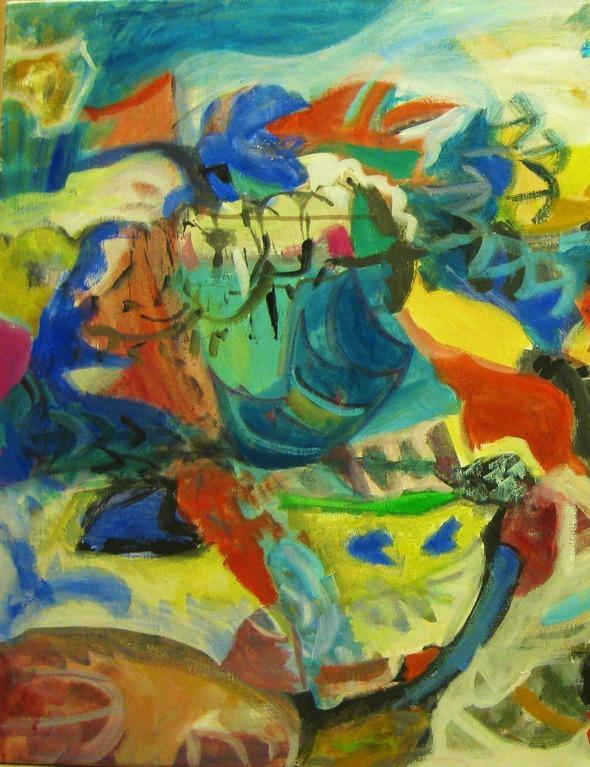 Flight to China
Flight to China

Another Day of Rain
You often alternate between landscape inspired painting, abstraction, and collage, and your works — as the interesting Escape From Winter — feature such stimulating dreamlike ambience, that provides its figures with ambivalent and a bit enigmatic visual identity, that seems to unveil the bridge between the real and the imagined. Scottish painter Peter Doig once remarked that even the most realistic paintings are derived more from within the head than from what's out there in front of us, how do you consider the relationship between reality and
imagination, playing within your artistic production? Fiona Stanbury: I agree with Peter Doig. I have always questioned what is in front of me because much of reality is filtered through what we believe is there and I don’t want to take visual reality for granted because it can seem different on different days. I often wonder if we really see things as they really are, and of course that ‘reality’ will vary from person to person. I take my starting point from the premise that I want to create my own visual reality

on my canvas – I’m as much a part of nature as the world around me and my imagination or interior world is as real and is formed from memories that have mutated over time, and experiences of moving through the physical world.
I particularly like to play with thick paint because it has such a physical reality and in Escape From Winter I was pulled into a world that for me rang with all kinds of exciting associations and memories of places, and at the same time I had the
excitement of finding myself in a new terrain. This is one of the reasons I paint. The relationship between reality and imagination is one of the main aspects of my work. I’d like for the viewer to enter a new place with its own rules and space. Escape From Winter, while about wishing the greyness of winter to pass, was also about finding my way through slabs of colour to create almost musical notes and movement across the picture. It was heavily worked on with many changes which then became part of the painting. I like the idea of the thoughts of the artist
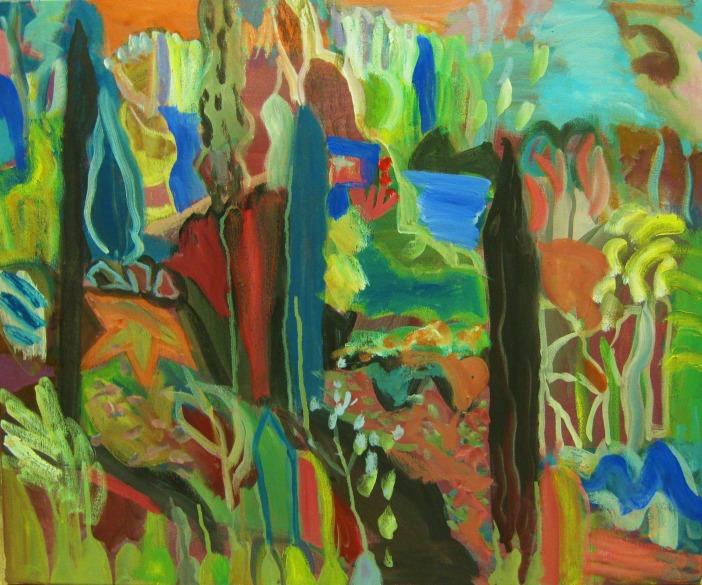
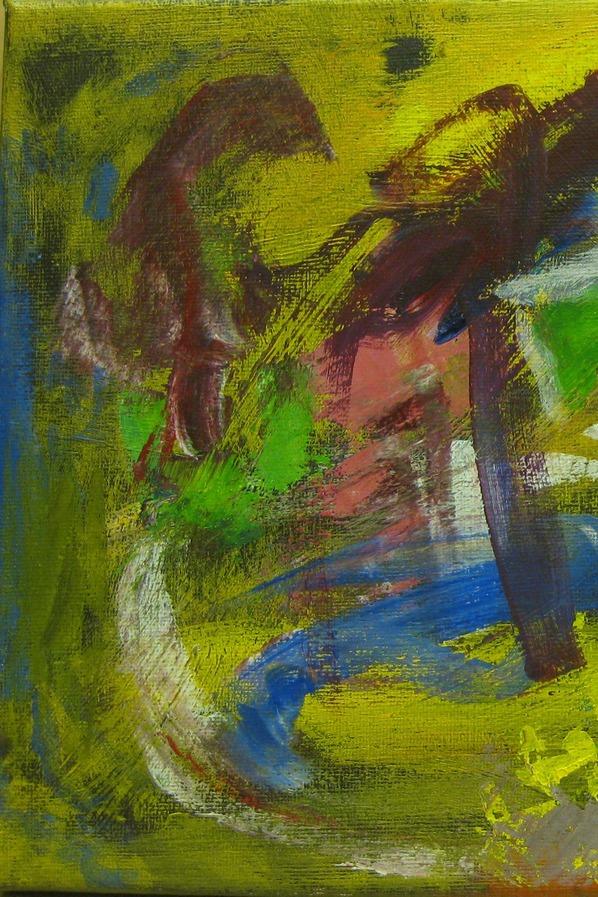 Winter Birdsong, Dusk
Winter Birdsong, Dusk

becoming marked by paint.
I’m not too worried how my paintings can be categorised, whether I’m seen as abstract or figurative, because my spiralling approach widens how I think about reality. I often overlap
abstraction with figuration and recently I’ve been making abstract collages. One of the things I was told by a tutor at art school was not to think about how my work can be defined by others (curators, galleries, other artists) and to do what I need to do. Thinking about other’s definitions can restrict

My Somewhere Else
how you work and I want the paintings to please me first.
When exploring edges or shapes, your artworks feature thoughtful nuances — as Three Escape The Deluge — as well as bold tones in Lemba Sunset.
Moreover, we have particularly appreciated the way they create such enigmatic patterns, communicating tension and such dreamlike ambience. How does your own psychological make-up determine the nuances of tones that you decide to include in an artwork and in particular,
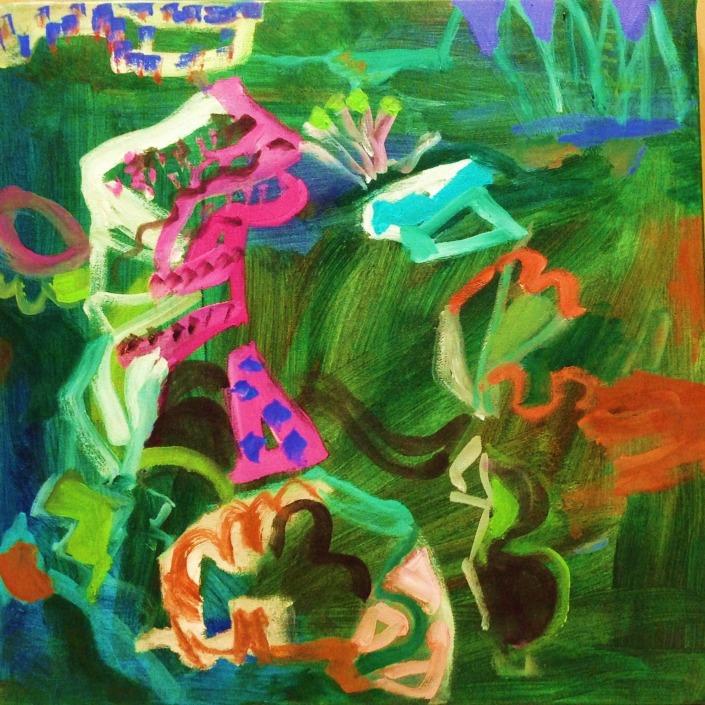
They Passed Many Trees on Their Way to the Mountains


how do you develop your textures in order to achieve such unique results?
Fiona Stanbury: My psychological make-up is such that I totally enter the arena that opens up from the actual placing of marks and colour. There are no words in my head or labels, just an immersion in this real place. It’s totally a reality for me. So I tend to let the materials suggest ways forwards. Colours will feel right or may change completely during painting. For example, I love the way paint can be used thick, thin, and layered, and I take clues from their suggestions or patterns that may emerge, The important thing for me is to follow cues the paint begins to set up and if necessary to destroy parts of the work to set up better cues.
In Three Escape The Deluge, I took the coloured jigsaw puzzle pieces from another painting as they suddenly felt relevant to this piece to anchor the sense of movement, water and people. These were shapes I had developed previously in a very large painting created for the Dafen 1st International Oil Painting Biennale in China (2018). The painting ‘Social Integration, Peace and Opening Up,’ (on my website) was created for a theme about social integration, and my idea of people being bound together by colourful jigsaw puzzle pieces was the basis for this painting. I really liked their abstract shapes and they were an extension of my current ideas. In Three Escape The Deluge I wanted to contrast abstract shapes against textures and layers of colour and to give a suggestion of figures. In life we see things by means of contrasts and in my art I feel free to contrast whatever works for me. The textures were really important in this painting because I wanted to convey a feeling of landscape being destroyed by floods and a sense of upheaval. The nuances of colour were also important because I was thinking about the transition of colour and tone across the painting and kept the background colour a neutral tone so the brighter colours could make their meanings more coherent.
It’s also a painting that took some approaches from my ink paintings on rice paper. I’ve been working on rice paper since 2015 when I visited China for the first time for the Beijing International Art Biennale. At that time I bought ink, rice paper and calligraphy brushes and began to experiment. Rice paper makes you think
carefully about the kind of brush strokes, tones and composition you are going to pursue and I found myself having to make faster decisions and noticed patterns emerging from the way the ink spreads across the highly absorbent paper. Three
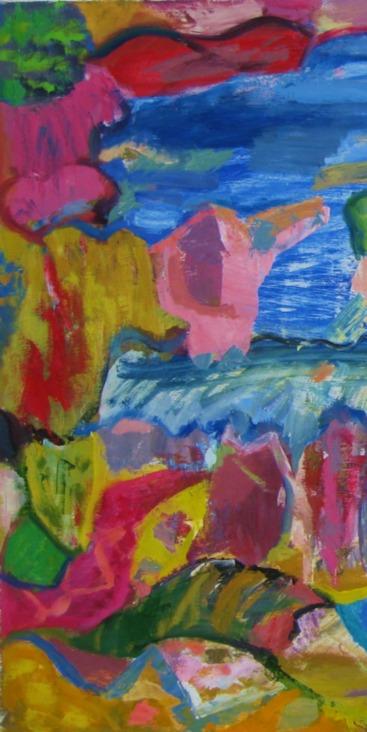
Escape The Deluge showed me that I could layer thin acrylic and ink on canvas and use ‘process’ more..
Paintings are always suggesting new elements
that suddenly feel meaningful and relevant to my inner world, though I can’t always say why. This not being able to say why is a positive strand of my work because I don’t want to know too much! Knowing prevents an open dialogue.
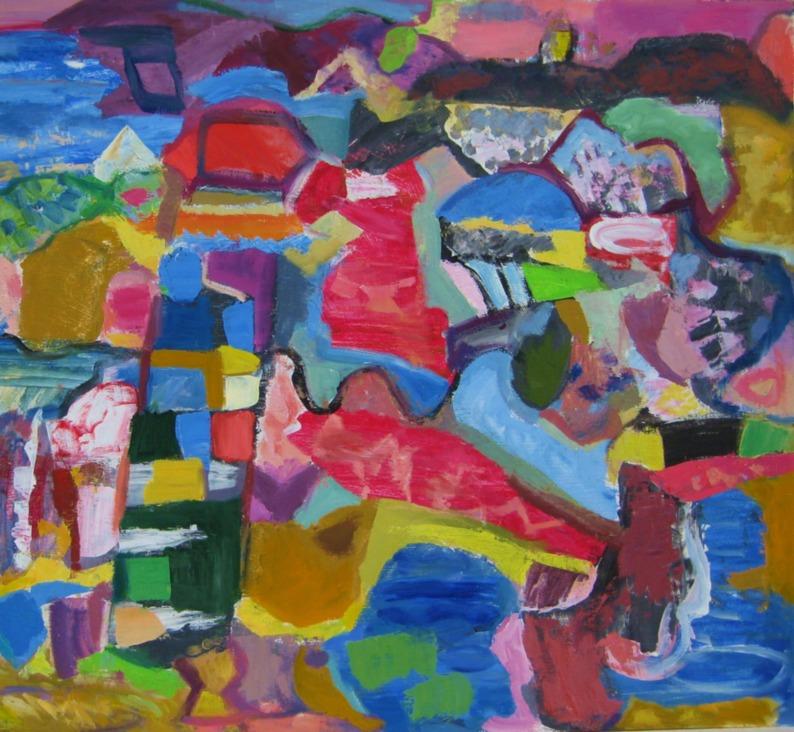
SUNSEEKERS
Although marked out with abstract style, your artworks are pervaded with effective narrative drive, and we really appreciate the way your figures work as bridge that shows the connection
between reality and the subconscious. To quote Max Ernst's word, human beings have an inexhaustible store of buried images in their subconscious and into their inner world: how does your everyday life's experience fuel your artistic
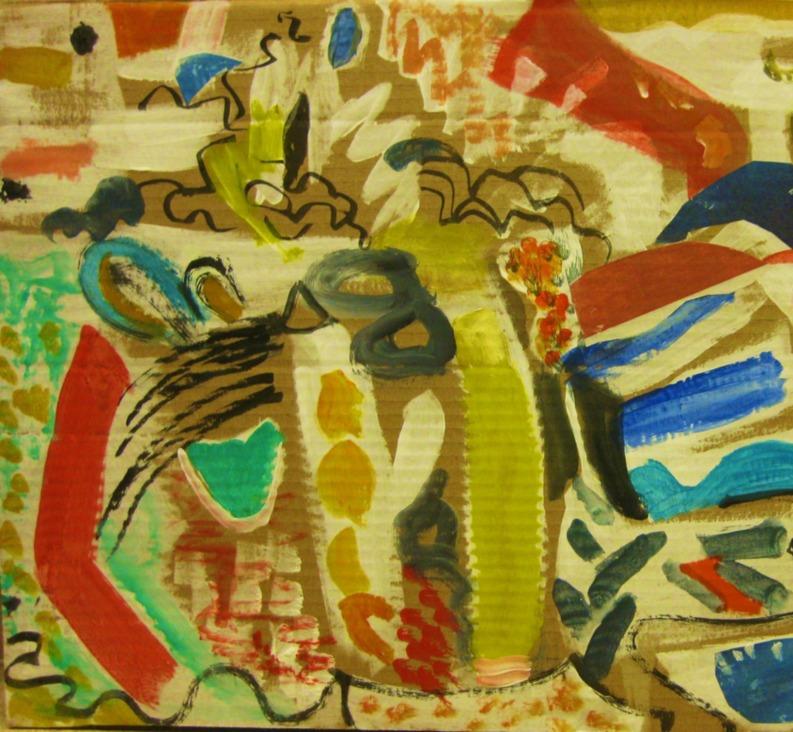
research?
Fiona Stanbury: I agree totally with Max Ernst. I’ve travelled a lot, lived in Cyprus and Africa, and certain visual identities from those countries have
played a part in how I see colour, patterns and textures. The memories are always with me in some form. I painted in the landscape for many years but eventually I found that the visual reality in front of me was not allowing me to focus on the kind of compositions and motifs or the paint elements that started to intrigue me, though these had been absorbed from looking at different landscapes over the years.. My interest was now the placing of colour, the dynamics of mark making and focus on the actual painting as a world in itself. I found that adding particular landscape elements such as leaves or clouds were interrupting the flow of focus and detracting from the power of the kind of image I wanted to make. The next problem was how to make shapes and colours meaningful when they are not hinged on details from the environment. This is something that continues to pre-occupy me. It brings up new questions which I address in different ways.
My 14 years in Cyprus was a pivotal experience because I met the great artist Glyn Hughes who became a mentor and we had many discussions about art over the years, did workshops together and set up exhibitions. His large abstract paintings full of colour influenced the way I had considered colour up to that point. I also painted Nicosia from rooftops and these led me to explore ideas of pattern and colour in a way that would never have occurred if I had not had that opportunity. I saw artwork from all over the Middle East and many different approaches.
My everyday life experience, whether walking in the land or working on canvas, involves considering visual realities versus paint realities and feeling in an intuitive way how I might extend my paint poems in relation to what is important from the world around me. It’s a constant questioning of what is relevant and sifting through that during the act of painting.
Meaningful for me is the authenticity of the world I’m creating but as I progress from the exciting beginnings, the search becomes very intense.. I feel as if I’m excavating meaning through my process and response to the paint. There is a very fine line between what is relevant and what is not.
The visual qualities of the paintings have gradually become more important and more expressive of my
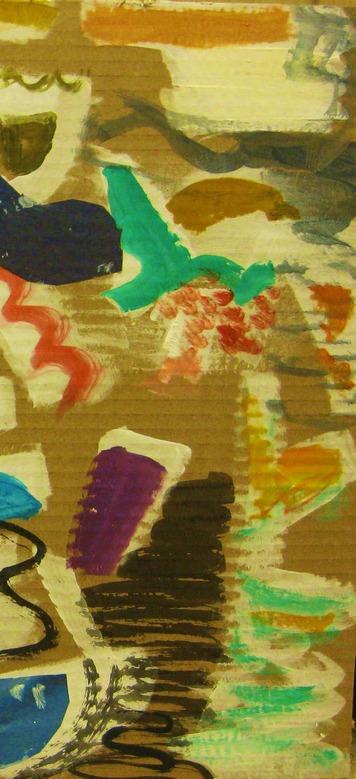
relation with the world. For example, Winter Birdsong: Dusk is a painting about my walks back through a forest from a place that I loved and which has now closed called Burrswood. It is based on many memories of that long walk through the forest at dusk after a day’s painting. The particular time of day and season that most captured my sorrow was dusk in the winter. At that time the last, shrill notes of the birds paralleled my emotions and I wanted them to appear as notes of acid colours in the encroaching darkness. This is a theme I’d like to revisit because I could explore the emotional significance of colour further and the dynamics of composition as I feel it is developing for me.
My alternating approaches include working from memories of places, such as in Paphos Lighthouse Remembered and Lemba Evening (collage and paint) during which I have specific forms I want to use, or allowing the process and paint to create a place, as in The Sound Of Colour: Fiona’s Place. In this painting the shapes were not taken from any memories, they were dictated by the paint. However, it is important to work from some specific references at times as well as working completely from the paint to research my vocabulary.
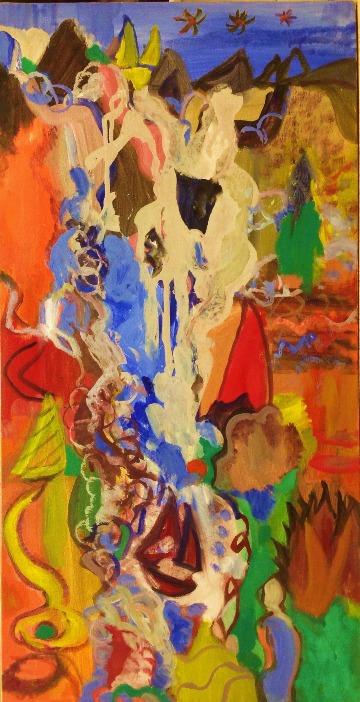
With their unique multilayered visual quality, your artworks have several different strands but they are all connected to a core vision: how important is it for you to trigger the viewers' imagination in order to discover the unity of your artistic production? In particular, how open would you like your works to be understood?
Fiona Stanbury: I believe that not every viewer will understand my paintings or perhaps feel able to enter them. It will depend on how they expect a painting to look or what kind of visual references they want to see present. Any visual language will not necessarily be accessible for everyone. Paint can be used to translate so many different visual and emotional experiences and all are valid forms of expression. I would like my colours to give a positive influence and joy and for the various elements in my paintings to invite the viewer to
Safe Passage
look further and discover their own meanings or to ‘see’ something new. Some of these paintings will be more accessible than others and the titles may facilitate understanding in some cases.
An example of this would be ‘The Sailor’s Song.’ I set
myself a task with this one. It was inspired by my father’s stories about navigating huge waves during his time piloting ships as a Commander in the Royal Navy. He used to tell me about the sailors’ prayers to reach safe land. When I began
this painting I knew I did not want to paint blue sea. I wanted an evening scene when the sea reflects the setting sun. There are rocks, boats, high waves, and in the distance a safe harbour. I deliberately left some elements ambiguous and I

wanted the colours to carry the viewer through the idea of peril at sea.
Though my work has several strands, I think that the way I make marks and combine textural aspects of paint probably shows a unity of artistic production. My various series also have a unity of theme. In particular, is it important for you to select titles that could tell something that might walk the viewers through their visual experience?

Fiona Stanbury: My titles are very important though they come about in different ways. Sometimes I start a painting from a title, such as Another Day of Rain, which describes my frustration about the months of rain in the UK! I’d seen images of flooded fields and houses on the News and this, along with my flooded patio, fuelled this painting. At other times the title emerges through the developing imagery. Sometimes the titles may guide the viewer in to the visual experience and sometimes I want the painting to be slightly ambiguous as in the collage Sunseekers. In that artwork I wanted the colour to express the brilliance of sunlight in a warm country, for example, such as Cyprus. In such works I think the title can guide the viewer to what is a purely visual experience rather than being a narrative experience. At the same time, titles will mean different things to different people and I don’t want to force an idea on someone, I’d like each viewer to find their own meaning.
Another way I start a painting is from a list of titles which I write as prompts for paintings. They may contain words that have narrative references or concern thoughts about places or issues. That can be a helpful doorway into creating an image because it forces specific references to be translated and is not so open ended.
There is also a series of paintings called ‘My Somewhere Else’ which are about researching paint qualities and seeing what kind of place they create. In the painting reproduced I was trying out a different kind of canvas, much smoother than usual, and the washes of colour caught in the slight grain in a beautiful manner, almost like watercolour, which suggested a landscape and I left my ‘tracks’ across it with brush strokes of colour. I’ve always drawn with
The Sound of Colour

colour, even as a child, and this was further encouraged by my wonderful tutor Stass Paraskos at art school.
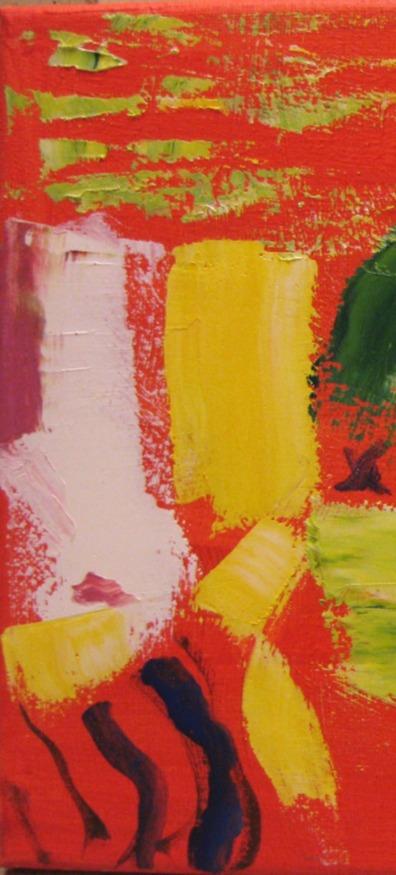
Mexican artist Gabriel Orozco once stated, "the artist’s role differs depending on which part of the world you’re in. It depends on the political system you’re living under": do you think that your artistic research responds to a particular cultural moment? Moreover, as an artist particularly sensitive to ecological issues, do you think that artists can raise awareness to an evergrowing audience on topical issues — as the theme of global warming — that affect our globalised and everchanging society?
When I first began writing this interview the coronavirus was not impacting on our lives in the world as it is now. I see artists every day making work about this and responding in different ways to this particular moment. The audience for such works is growing and artists are exchanging ideas more than ever on social media during times of enforced isolation. I’ve always believed that artists can influence the world around them on important issues and create joy during difficult times.
I’ve painted canvases as submissions for themed exhibitions in China which had particular social themes or narratives. The artwork previously mentioned Social Integration, Peace and Opening Up, a narrative work about world integration and the meeting of people, encouraged my interest in painting about world issues such as climate change. Making paintings for briefs, such as the Chinese Biennales, brought figures back in to my work after some years absence. As a nature lover I really want to continue this series on climate change. Examples of this theme are Three Escape The Deluge and Stranded Boats and Lotus Leaves. This ongoing theme is evolving from my multilayered approaches.
At the same time, sometimes we live amongst so much noise both physically and mentally that I like to paint about going missing in the land as an antidote for the complexities of daily living. Such a painting is B Went Missing In The Land and I wanted to convey the joy of being amongst colour.

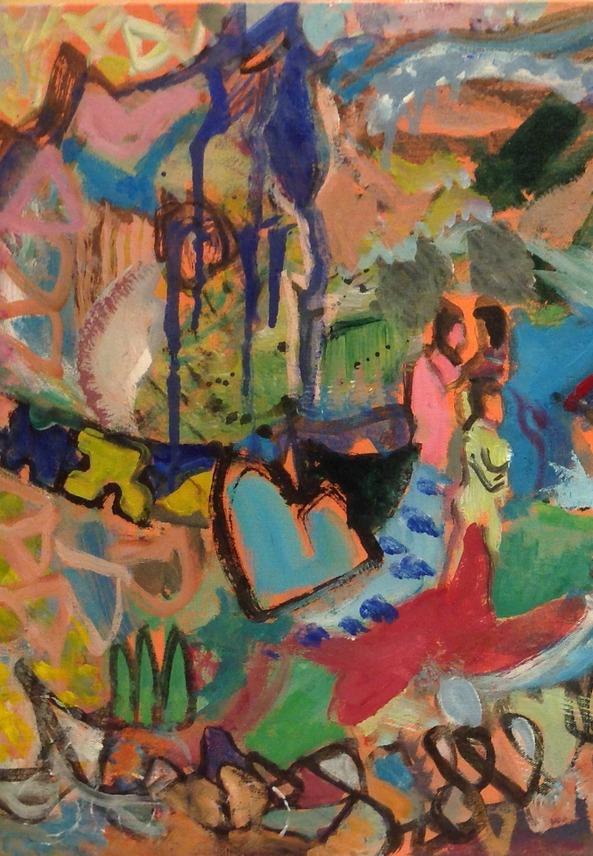


This has particular significance now when our daily walks are restricted. I also feel very strongly that a painting should be seen as paint on canvas and that you can do whatever you want. It’s not primarily about the market, for me. I want to be true to my language and vision. One of my favourite artists has always been Kandinsky because I love the way that his paintings are extra places beyond the visual world.
Currently I’m making a series of paintings about the coronavirus, mostly concerned with isolation. As I am restricted in my walks outdoors I am finding new ways to explore my internal landscape. Figures are blurs that pass by at distance now. I’m thinking of how to translate this experience.

You are an established artist: your artworks are in several collections in China, Latvia and Cyprus, and over the years you have exhibited internationally on several occasions, including your participation to the 6th Beijing International Art Biennale: how do you consider the nature of your relationship with your audience? Direct relationship with the viewers in a physical context is definitely the most important one, in order to snatch the spirit of a work of Art. However, as the move of Art from traditional gallery spaces, to street and especially to the online realm — as Instagram — increases: how would in your opinion change the relationship with a globalised audience?
Fiona Stanbury: Online relationships through social media, blogs and the internet are a really important way to reach a wider, global audience and it’s important to me to be fully conversant with all these platforms. It’s also an important way to connect with other artists, and seeing their work challenges my own approach and can extend my way of thinking so I welcome this.
At this time of writing the coronavirus is changing the way we communicate during enforced times of isolation and generally in relation to keeping in touch. I’ve seen all kinds of art movements and support systems for artists – in particular the #artistsupportpledge – starting up (through the artist Matthew Burrows), and I feel that these new resources will change the way in the future that we engage with online content. I’m also thinking that when galleries finally reopen, online resources will
feature more than ever in the marketing of art, though possibly artists will have found new ways to promote themselves on a global platform. Art has also been a way to share ideas of hope and the works I see my friends creating uplift me and make a link to a positive future.
Also, writing is really important for me both creatively and for purposes of evaluating my direction in as far as that is possible. I have been writing an artist blog for 10 years and through it I like to evaluate my current focus, share thoughts and tips, and generally extend ways of sharing my artwork. The blog is also shared across other platforms such as Linkedin, Facebook, Twitter and mentioned on Instagram. I’m including the links to Instagram and my blog.
My artist’s blog:
https://strandedartist.blogspot.com/
https://www.instagram.com/fionastanbury/
My large painting ‘Social Integration, Peace and Opening Up’ has been included in a section called ‘Love Can Defeat Virus’ on the website of the Beijing International Art Biennale. Previous participants were invited to submit paintings for this section. In this way the Beijing Biennale committee wanted to raise awareness of the virus and to create a positive response.
http://www.bjbiennale.com.cn/en/ExhibitionNews/202
003/t20200310_475121.html
We have really appreciated the originality of your artistic production and before leaving this stimulating conversation we would like to thank you for chatting with us and for sharing your thoughts, Fiona. What projects are you currently working on, and what are some of the ideas that you hope to explore in the future?
Fiona Stanbury: I’m currently finishing a very large canvas exploring a theme of Co-existence for an exhibition in China later this year. This has a strong narrative approach, and will be on my website soon. I see this theme being developed further in the future but may take it more towards abstraction. The questions abstraction raises still preoccupy me..
As the impact of the coronavirus increases daily, it is beginning to enter my paintings in all kinds of ways, either through wishing to enter a joyful place of escape or through a desire to reference this in a narrative way. I feel that this difficult time will change the course of artwork for many artists or force them to re-evaluate ways of thinking about art.
I’m making several collages and I’m resolving some unresolved canvases in the light of new elements suggested by the collages. I’m about to continue my theme Flight to China because I feel that it’s giving me a free artistic expression and I like where it’s taking me. Questions of ‘intention’ keep coming up and I like that.
I’m also keeping very busy by being a part of the 12ocollective’s project #30works30days which can be seen on Instagram and their website www.12ocollective,com. We have to create a new work daily and it’s a really helpful kind of pressure to be under and I want to do things I haven’t done before to widen my net further. I feel very positive about the new work and ideas that will be generated as I go along, and it is also really warming to feel part of a collective movement.
I feel that it is very important for artists to keep working and sharing, if they can, at this time of isolation because it shows a sense of movement and gives some idea of normality and forges a positive idea of the future. More than ever I’m exchanging ideas with artist friends around the world and this helps disperse the sense of isolation.
Many thanks for including me in ART Habens and for your interest in my paintings, I have enjoyed this conversation very much and it’s been helpful to have to verbalise my intentions and ways of working.
ART Habens Fiona Stanbury

